When you don’t rely on third-party players like wholesalers and retailers to sell your products, you gain a tremendous amount of control over your customer experience. It’s liberating.
At the same time, DTC space is a busy one, and it’s easy to get drowned in countless products and brands competing for the same customers as you.
What are some key DTC strategies brands leverage to stand out? Which DTC brands should you learn from? Keep reading to learn more.
Table of contents
- What is a direct-to-consumer brand?
- Direct-to-consumer brands: a short history overview
- What makes DTC brands stand out
- DTC brand examples to inspire you
- How Shopify can help your DTC brand grow
What is a direct-to-consumer brand?
Direct-to-consumer brands, or DTC brands, are those that sell directly to the end customer rather than relying on middlemen like retailers and wholesalers.
This approach gives brands more control, as well as responsibility, over product sourcing and manufacturing, stock levels, order fulfillment, and customer experience.
DTC paves the way to a more efficient buying journey for consumers. It’s no surprise that DTC ecommerce sales in the US are predicted to hit$161.22 billionby 2024.
Direct-to-consumer brands: a short history overview
Today’s DTC model exists thanks to the internet, but the internet isn’t what kicked off this business model.
One of the earliest known instances of selling directly to consumers happened in 1785, whenmilkmen began delivering bottlesof milk to customers’ doors. In 1886,Avonstarted selling beauty products through a female team of sales representatives, a radical business model at the time.
Another historical DTC brand, Tupperware,launched in 1946and started selling to consumers directly in their homes. During the 20th century, we also saw clothing manufacturers ditch wholesalers and open their own retail stores.
Finally, when the internet became more widely available during the early years of the 21st century, we saw the birth of digitally native brands like ModCloth, Bonobos, and Warby Parker.
In the past decade, some digital-first brands went on to open retail spaces, while some that relied massively on retail partners,like Nike, only began to explore a DTC approach.
What makes DTC brands stand out
Some estimatessay there are over 110,000 DTC businesses in the United States.
So while DTC-first companies don’t compete with products sitting next to them on the retail shelves, they compete with thousands of products people can purchase online from the comfort of their own home.
The question that naturally comes up is: what makes some brands grow and stand out from the crowd?
The answer will vary for each brand, but there are some common threads you’ll see with successful DTC businesses:
- Strong mission.Some DTC brands are driven by a clear mission and a goal, like MUD\WTR with tackling caffeine dependence or Pulp Pantry with reducing food waste.
- An innovative product.Brands like DEUX and Cometeer are successful because they created products in an area where they don’t have significant competition (at least not yet) but that their target audience wants.
- Backstory.Products like spice blends from Marc’s Magic Rub carry the story of founders’ dad in every touchpoint. It’s what makes it memorable and meaningful.
- Creative marketing.Some brands go so far outside the box with theirmarketingthat it’s impossible not to notice them. Case in point: Liquid Death, a canned water brand.
- Educational hubs.在教育内容上下大工夫,companies like Biossance and Ten Little become the go-to brand for all customer questions and issues.
- Positioning.You can sell a product that customers have seen a thousand times in their life, but position it in a specific way to make it more desirable to specific types of customers. G FUEL nails this with its esports and gaming focus.
- Tone.When done right, a bold tone of voice is memorable and attractive. Look at The Ridge, a DTC brand that sells slim wallets. Its entire social media presence is focused on ridiculing bulky wallets—and it works.
When you see a DTC brand that stands out, you’ll find one of these approaches as the pillar to their success—and sometimes an additional one or two that complement it.
For example, Diaspora has a mission to make spices delicious and its supply chain transparent, but it’s also supported by its founder’s origin story.
DTC brand examples to inspire you
1.削减的衣服

削减的衣服workleisure服装闻名,workw的风格吗ear that pairs style with comfort. The brand specifically addresses ambitious people, saying its mission is to “inspire those who compete and win in the Sport of Business.”
削减的衣服takes a bold, rare approach to positioning its products. Its Twitter bio states the brand is in the business of “outfitting the world’s most ambitious people.” It's no wonder, then, that Cuts’ founder and CEO, Steven Borrelli, hostsThe Sport of Businesspodcast where he interviews entrepreneurs, investors, and elite athletes.
The brand also has a habit of posting about pro athletes wearing its apparel, which aligns with its focus on ambition and success:
削减的衣服seems to have struck gold by merging seemingly opposing concepts: dressing for the occasion and feeling cozy at the same time.Nik Sharma, a DTC consultant and investor behindSharma Brands, wrote this about Cuts Clothing in a recent newsletter:
“I’m wearing the joggers right now, and they're some of the most comfortable pants I own. They feel like sweats, or something I’d sleep in, but they look good enough to wear out or to a meeting.”
2. Marc’s Magic Rub

Marc’s Magic Rubis a seasoning blend for foods ranging from ribs and chicken wings to salmon and even popcorn. The brand’s name, along with every online touchpoint with the store, honors the founders’ dad, Marc, who was passionate about barbecue and lost his life to cancer at age 59.
This is his family’s way of honoring and remembering him.
The blend is based on brown sugar and spices like garlic, cayenne, and marjoram. You can only buy two types of products: the original blend and the spicy blend, offered in different sizes and bundles.
The whole journey is minimalistic, streamlined, and focused on love for food and family.
3. Blume
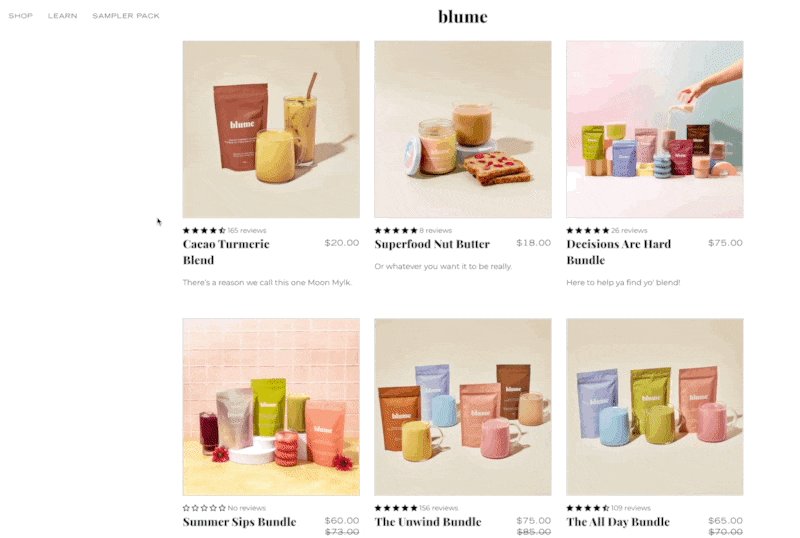
Blumeis a brand of latte blends with ingredients like cardamom, turmeric, reishi mushrooms, and lavender. Its products target those who love their daily coffee ritual and want to add a healthy kick to it—and avoid syrups and artificial flavorings.
Every interaction with Blume is delightful. The category pages don’t miss a beat in telling you which product does what (see GIF above). Product photos make you almost taste the product you’re looking at. And to top it off, Blume’s copy is sharp and funny—like “Here to help ya find yo’ blend!” product description line or the “All bloggity blogs” title for its blog.
Finally, there’s Blume’sTikTok, with recipes, funny videos made by Blume’s team, and the founder sharing her behind-the-scenes experiences. Customers love this, and Blume rewards them with a TikTok-specific code in their profile description.
4. Yellow Beauty
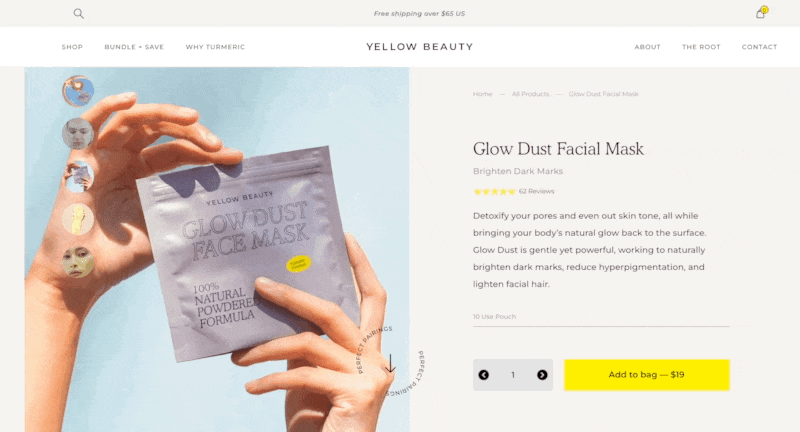
Yellow Beautyis a brand of skin care based on turmeric, founded and run by a Canadian couple. The wave of natural skin care brands only keeps getting bigger—this industry is expected to grow at a6.6% compound annual growth ratefrom 2022 to 2030—and Yellow Beauty has earned its space in it by focusing on this one focal ingredient.
This is what makes the brand stand out, and its visuals are the perfect aid to make it memorable. Just look at the colorful photos, product videos, packaging, animations, and even buttons and icons in the online storefront.
Yellow Beauty is anything but a bland and generic skin care brand—much like turmeric in dining.
5. Halfdays
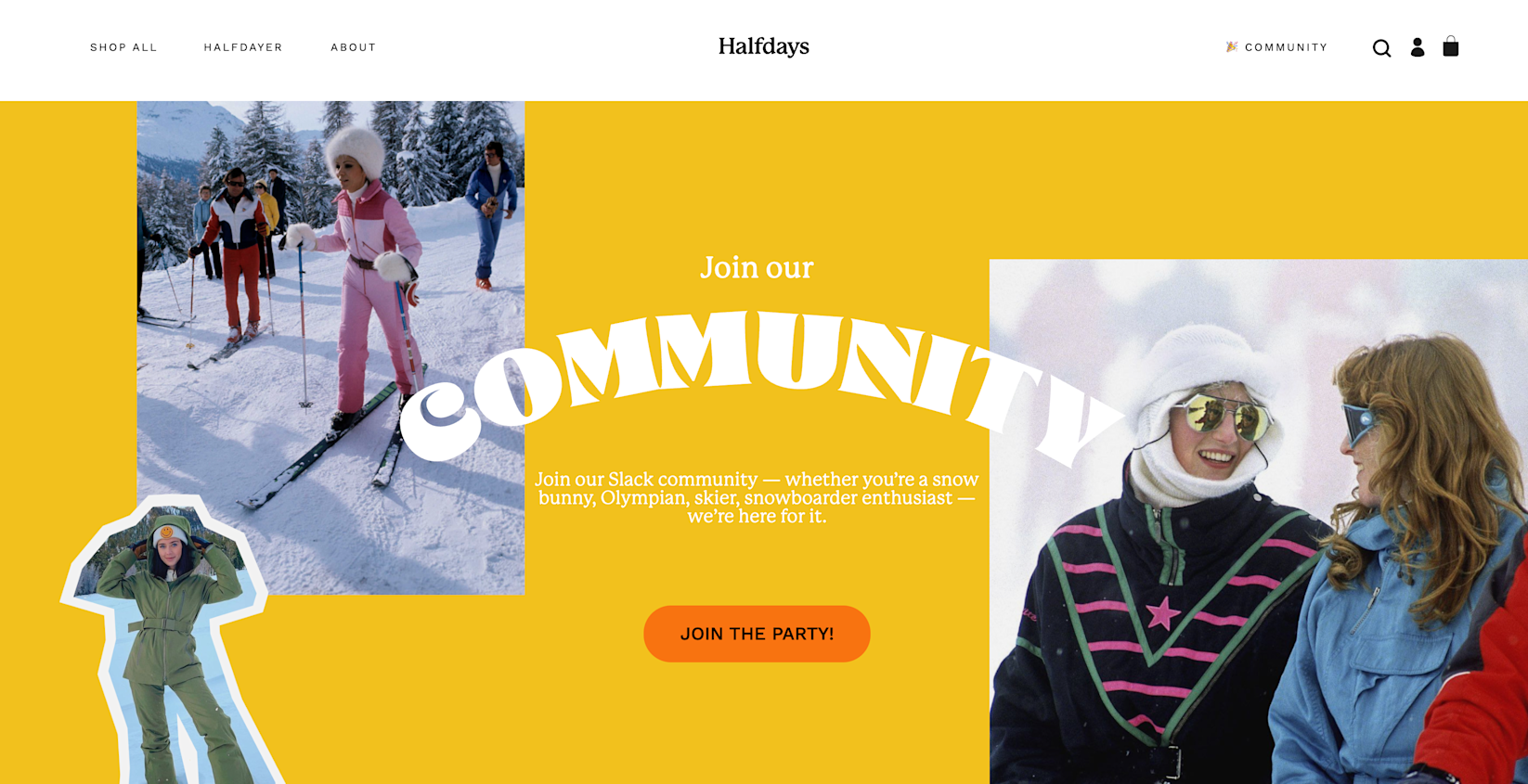
Halfdaysis a women's ski apparel brand that brings function, fit, and style together. Its homepage reads, “We’re here to shake things up.” Ski wear can be bulky and not-quite-fashionable, and Halfdays aims to solve that issue.
Halfdays is about more than just functional ski wear that looks good. It also runs a Slackcommunityfor skiing enthusiasts who want to talk about ski plans, arrange in-person hangouts, and get early access to new apparel launches.
The brand’s tone is also a tad cheeky—a “half day excuse generator” right in the middle of the homepage is a great example of this.
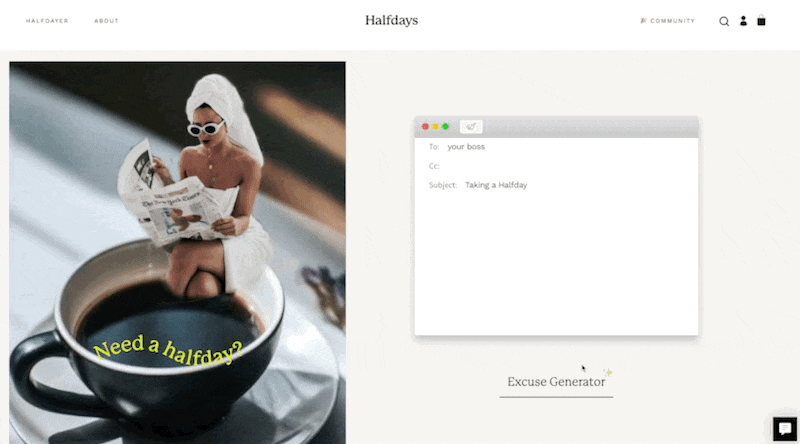
6. Pulp Pantry
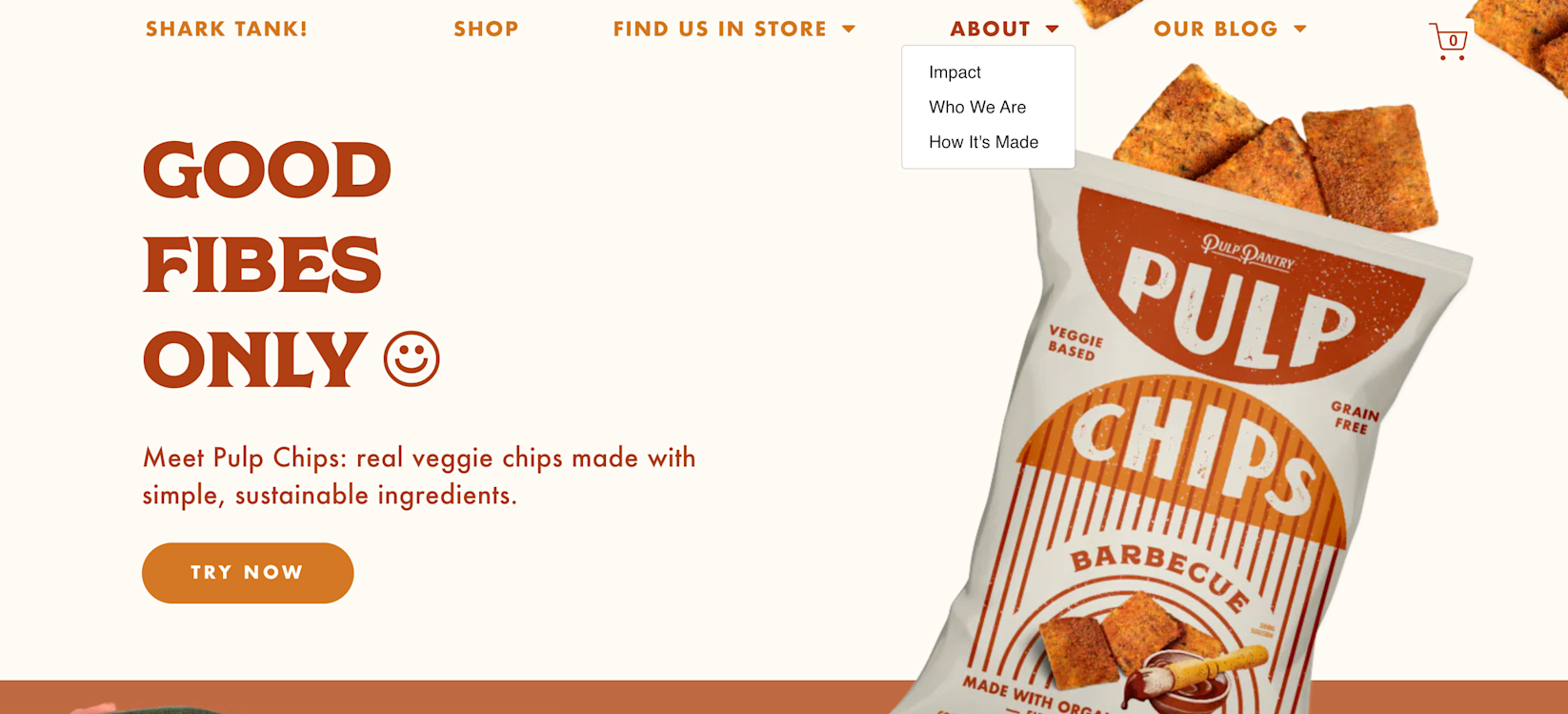
Pulp Pantryis a climate-friendly brand of crunchy chips. Climate friendliness is what makes Pulp Pantry different from the usual snack brands: the company turns pulp leftovers from juicing into chips.
This helps reduce food waste (in the US, almost40% of all foodis wasted) and gives customers an easy way to add more fiber to their diet.
Pulp Pantry’s mission is front and center across all of its channels, from the website and pages likeImpactto Instagram and Twitter. Earthy tones and straight-to-the-point copy ensure there are no distractions.
The brand started as a farmer’s market stand in LA and ended up onShark Tank.This helped it gain traction for its online DTC operation, as well as earn a spot in stores like Whole Foods and Fresh Thyme across the United States.
7. Joggy
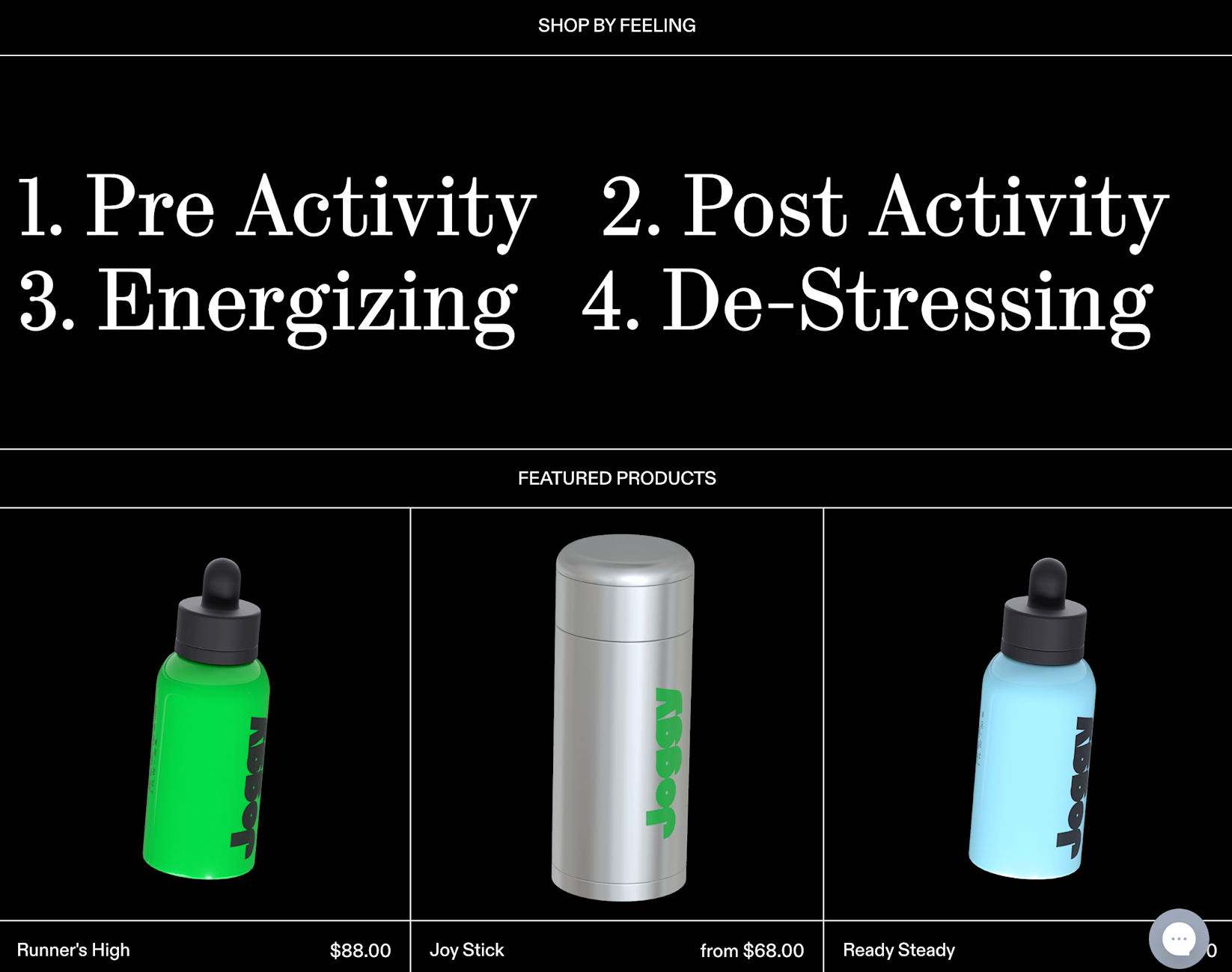
Joggyis a brand of plant-based energy supplements with full-spectrum CBD. Its products are made to support daily activity, individual performance, and recovery.
And whileCBD brandsare on the rise—CBD skin care and CBD oil are expected to reach$3.4 and $1.1 billionin market value by 2026, respectively—Joggy is carving out its spot in the market in three distinct ways.
One is an unusual visual identity: neon-colored products on a black background. The second one is Joggy’s focus on supporting an active lifestyle, including running metaphors in educational content, having a product called Runner’s High, and a huge focus on runners in its social media content (including user-generated content).
And the third one is its Web3community, with coins and collectibles that give community members the chance to shape the future of Joggy products.
8. DEUX
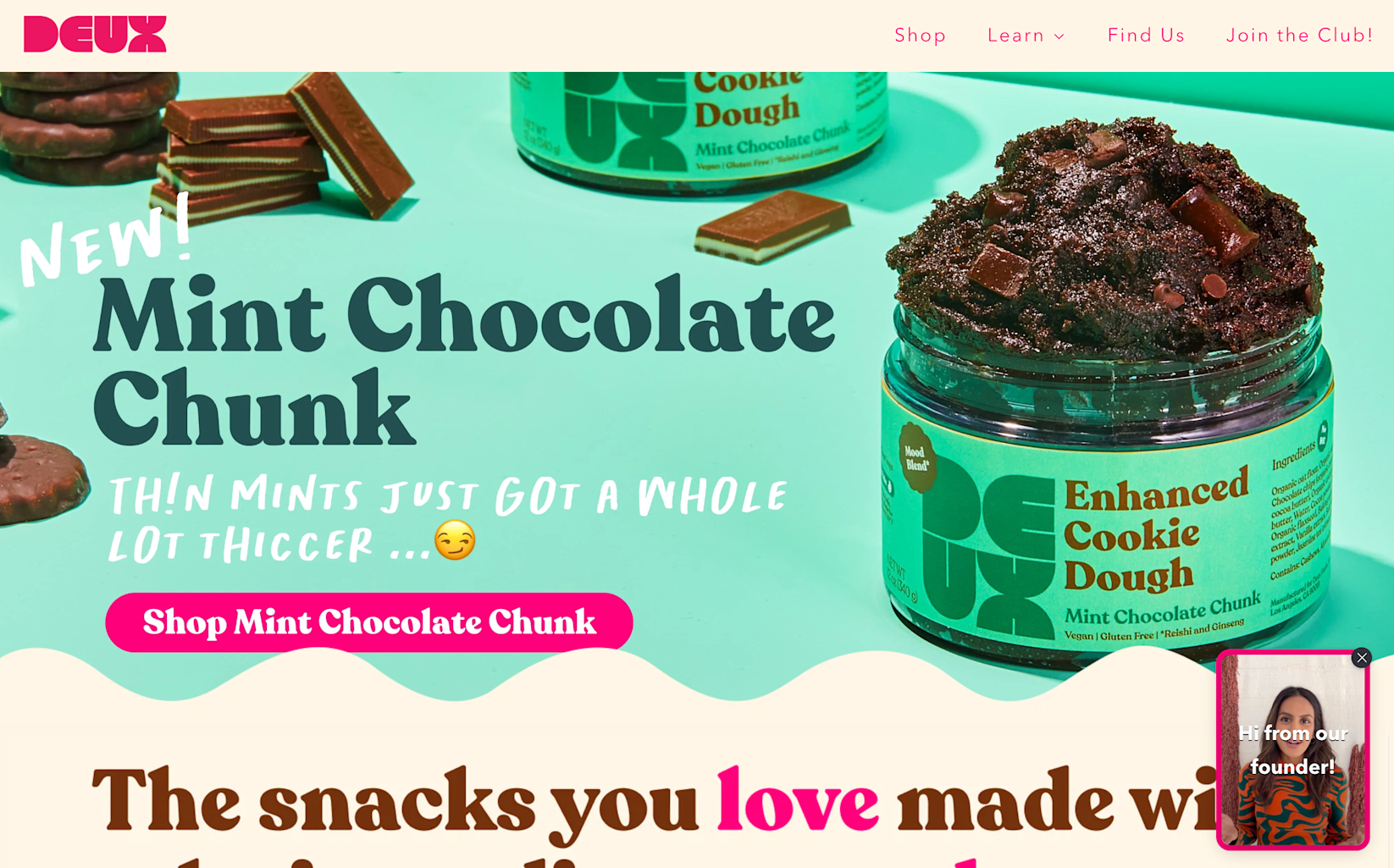
DEUXis a brand of vegan, gluten-free cookie dough products. These cookie doughs are made from simple ingredients—no refined sugar and preservatives—and have additional components that support health, like zinc, vitamin C, elderberry, and maca.
This puts DEUX in a unique overlap between the dessert and health product category. The company has carved out its position in it with loud colors, witty copy, and fiery takes on the food and dessert industry:

The visibility of DEUX’s employees is another approach that makes it stand out, including the “Hi from our founder!” video on the website and Instagram Reels of production, packing, calls for taste tasters, and even mistakes made in the process.
This gives cookie dough lovers frequent opportunities to connect with the people behind the brand.
9. The Ridge
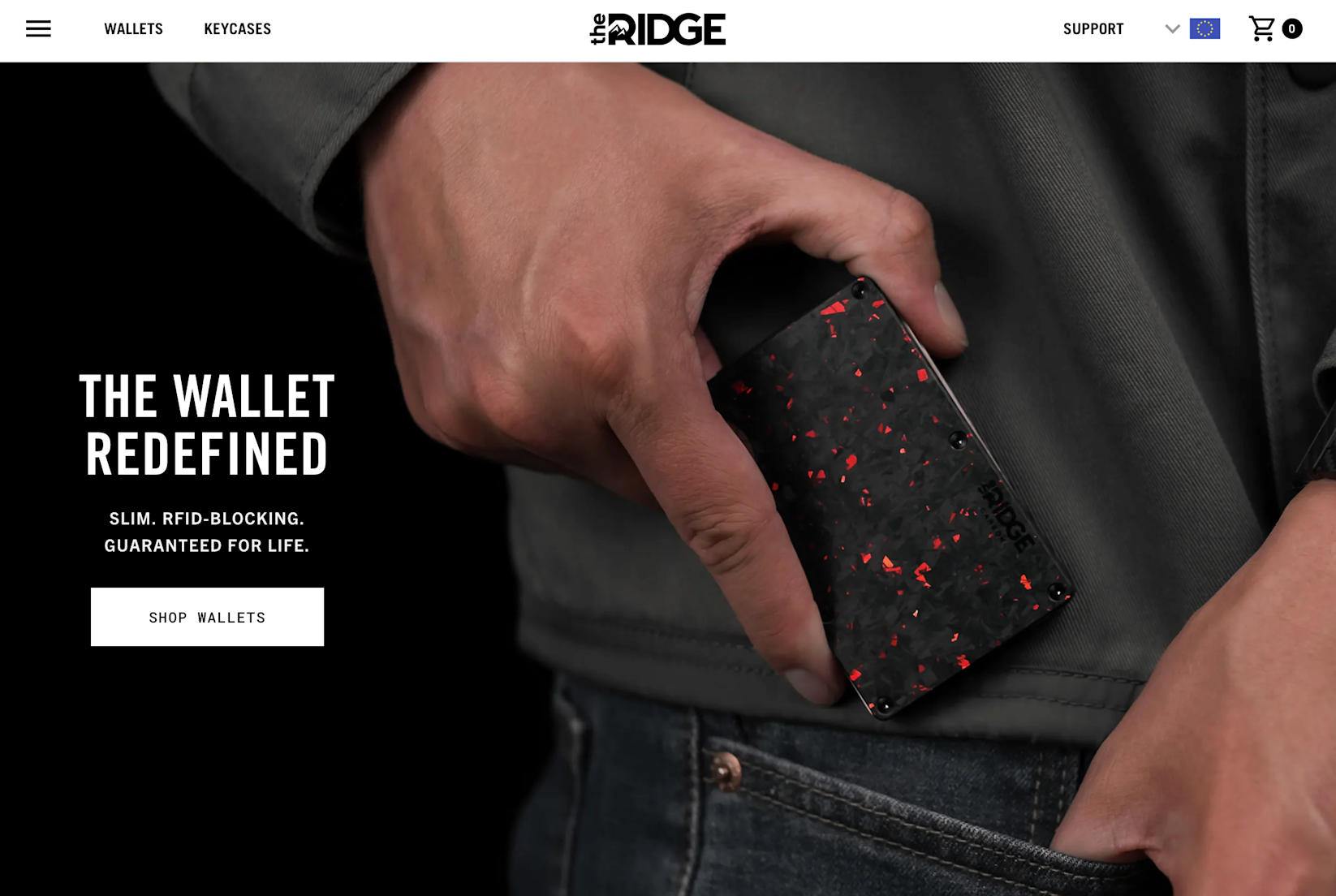
The Ridgeis a brand of slim wallets. It’s a minimalistic online store with only two product categories—wallets and key cases—and a couple dozen products total.
The Ridge’sTwitteris what makes the company unlike any other in its space. It’s full of sass, jokes, and regular digs at owners of leather, velcro, and otherwise bulky wallets.
The brand tweets with a consistent, unapologetically bold tone almost daily. There’s no shortage of memes and pop culture references either. The Ridge’s Twitter positions its products as the ultimate solutions for people looking for a simplistic and durable wallet—and entertains thousands of people along the way.
10. Three Ships
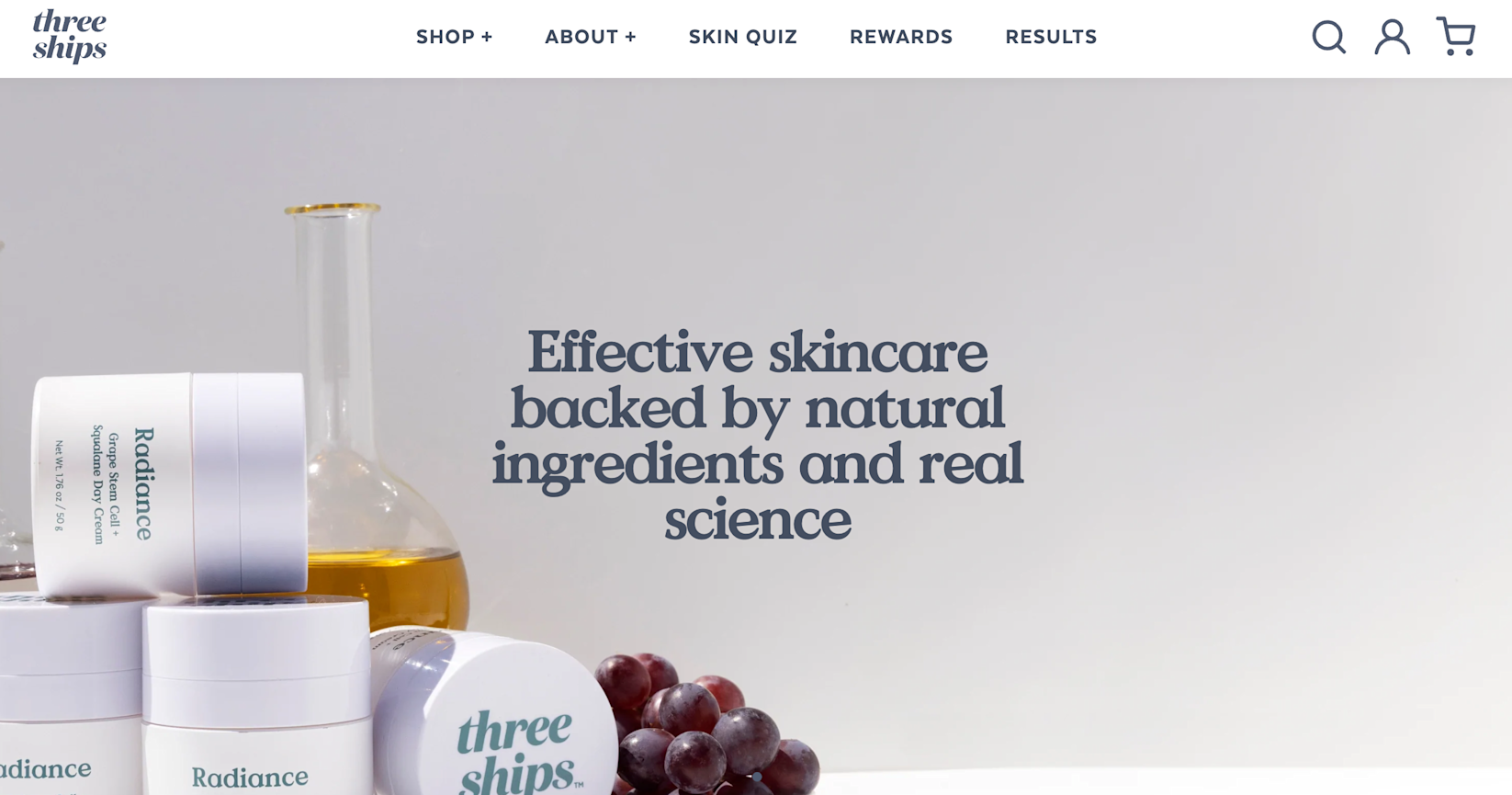
Three Shipsis a natural skin care brand. Its goal? To be the most effective and transparent beauty brand in the market. Effectiveness means less ingredients and products for better results. Transparency is about letting customers know which ingredients are in their skin care products,what they do, and how they were sourced.
Three Ships’ customers are its biggest ambassadors and the main way for new customer acquisition. The brand’s community is called The Fleet, and customers can give a discount code to friends and family.
“We’ve found that customers who come to us from a Fleet reference have a lifetime value that’s 150% higher than customers acquired through other sources. It just goes to show that the best marketing strategy is to have a great product that people can’t help but talk about and rave about to others,” Laura Burget, Three Ships’ cofounder,toldHappimagazine.
11. MUD\WTR
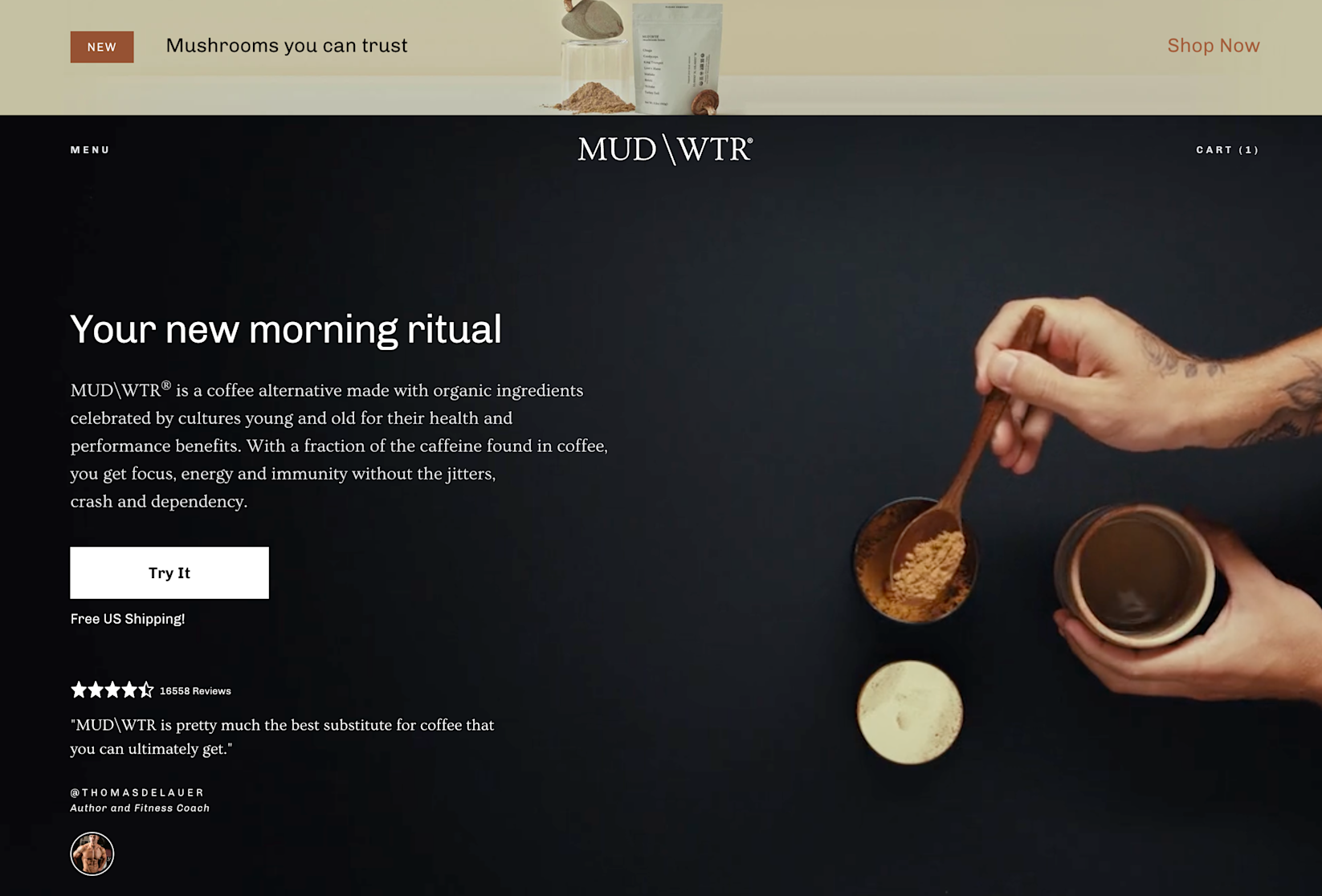
MUD\WTRis a mushroom coffee alternative brand with two core types of drinks (or “muds,” as the brand calls them): morning and evening. MUD\WTR’s key selling point is providing the same focus, energy, and immunity coffee usually does, but without the jitters.
The company’s mission is to help customers abandon caffeine dependency. It stands out by infusing this goal into product pages, FAQs, ablog, and resources like thecoffee detox program.MUD\WTR even donates a percentage of earnings topsychedelic researchand takes a bold stance on an often controversial topic.
And when it comes to being memorable, MUD\WTR makes the most of the post-purchase journey, too, with purchase confirmation emails, shipping emails, and beyond.
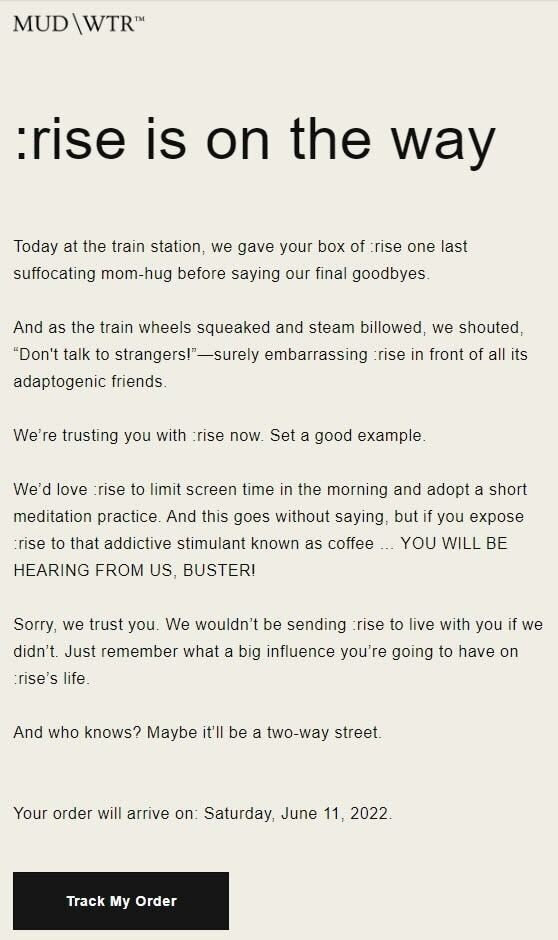
12. Feastables
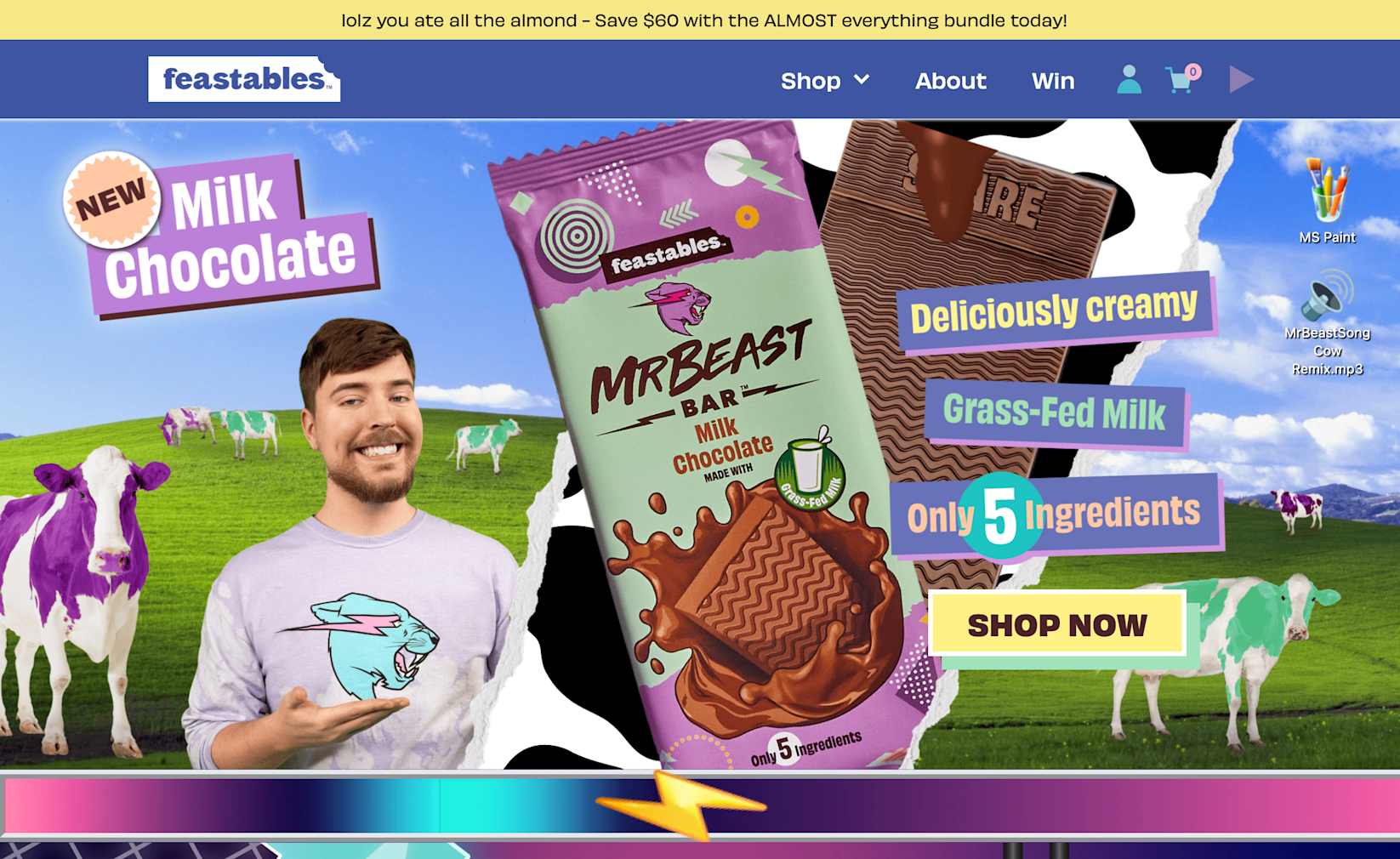
Feastablesis a brand of snacks by MrBeast, one of the most popular YouTubers of all time (with more than 100 million subscribers).
The first thing that makes Feastables jump out from other snack companies is its unbelievably loud presentation. That includes the entire homepage, from colors and playful copy (“You ate all the almonds” to say a product is sold out, for example) to callouts and animations.
The second thing is the premise of only five ingredients—ones you can pronounce, no less—in a chocolate bar.
And the third is, of course, MrBeast’s ability to bring millions of views to anything he does, including new product launches. For example, inone of his videoshe recreated Willy Wonka’s chocolate factory, held a competition inside, and mentioned Feastables’ latest chocolate bars. The video reached more than 90 million views in about two months.
13. Blueland
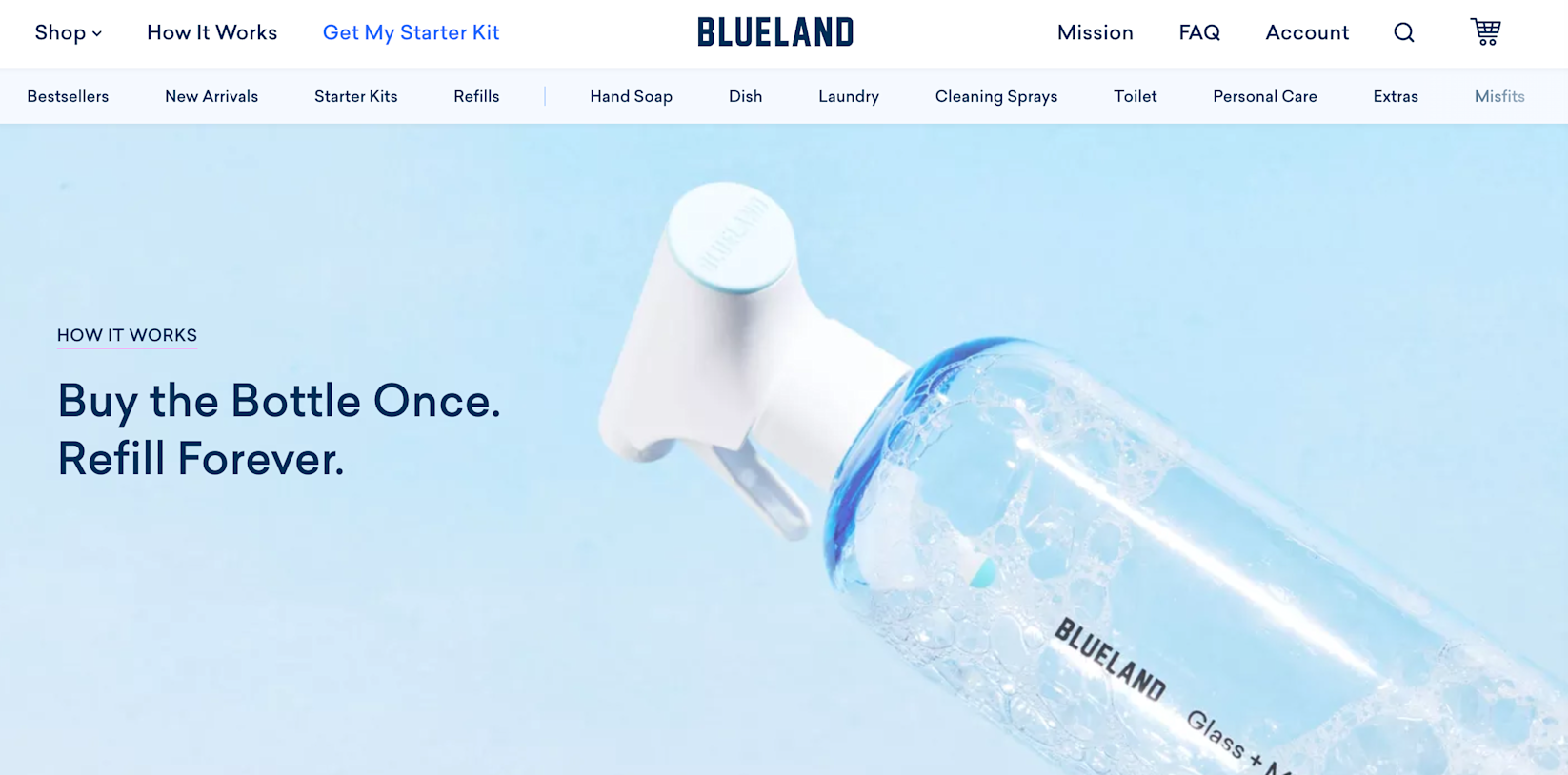
Bluelandis a brand of eco-friendly products for home and body care. Its product range is based on only purchasing the packaging, like cleaning bottles or soap dispensers, once, and buying plastic-free refills thereafter.
For example, Blueland’s multi-surface cleaner refill is a tablet that makes a full 24-ounce bottle of the cleaner when dissolved in water. A similar approach goes for facial cleansers and body washes. Laundry and dishwasher tablets are wrapper-free.
Blueland’s commitment to a cleaner planet is embedded in every product it offers, but the brand took it a step further. In summer of 2022,Blueland launcheda social media service that lets anyone tweet at the company for tips on recycling a beauty product by listing the brand (any brand!) and the location. Blueland will then respond with details on what to do.
14. G FUEL
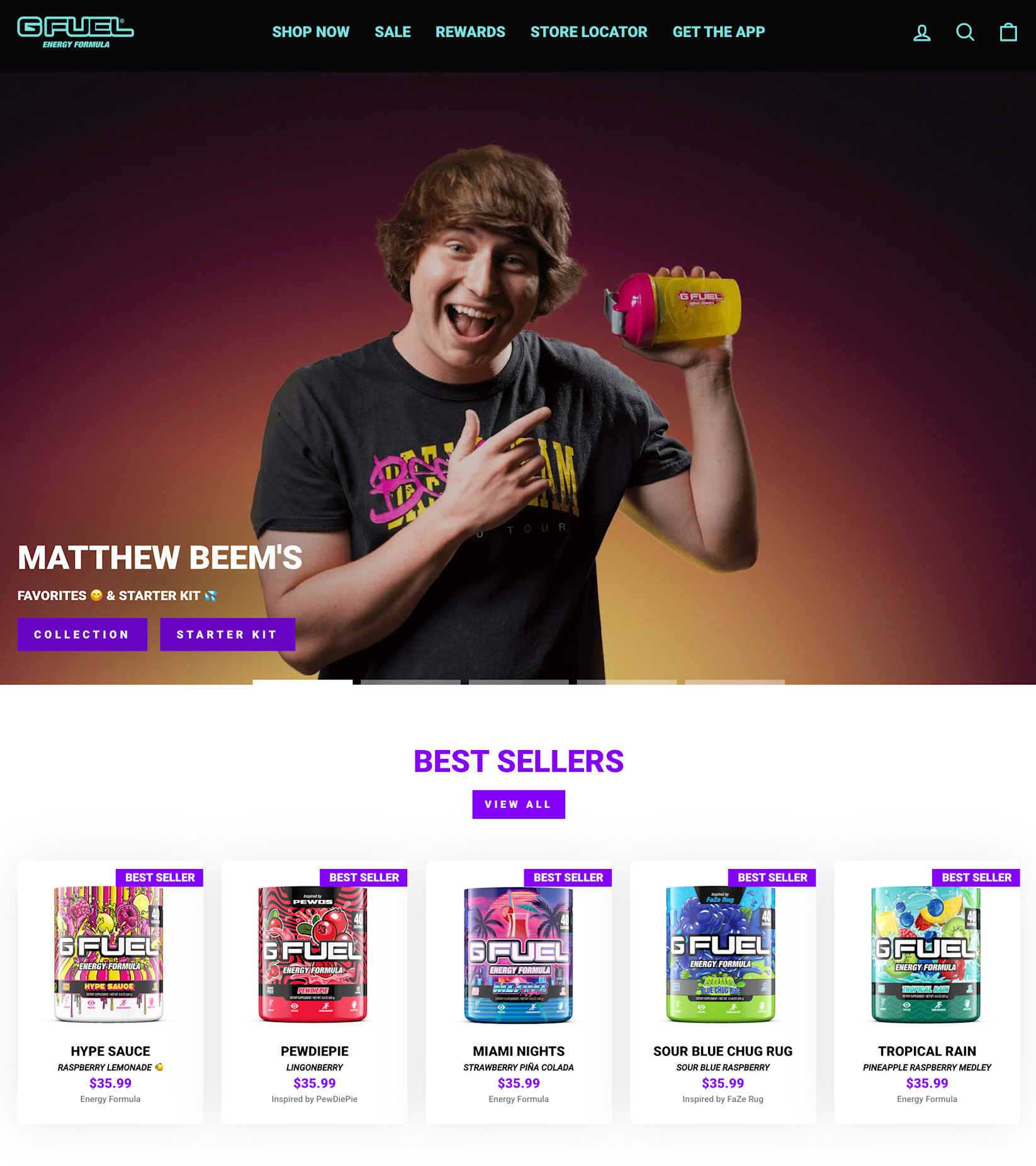
G FUELis an energy drink brand that carved out its place in the gaming and esports niche. It aims to give energy and focus tocustomers like“a casual gamer, a content creator, an everyday Joe, or an esports pro.”
G FUEL creates unique products and flavors by partnering with and sponsoring gaming creators like Matthew Beem, Alex Zedra, and PewDiePie. The brand named its partnerships program团队γ.
Another source of inspiration for product collections aregameslike Sonic and Crash Bandicoot andcomic book characterslike Spider-Man and Thor.
With a social media footprint of over one billion followers and more than 300,000 five-star customer ratings, G FUEL is definitely doing something right.
15. Pepper

Pepperis a bra company aimed at small-chested women—meaning AA, A, and B cup sizes.
“Bras for small boobs” is Pepper’s tagline, and it represents exactly what Pepper does well: speak to its ideal customer through website copy.
Pepper nails every line of text. “No more cup gaps,” the hero section claims. There are also lines like, “Not all small boobs are the same,” “Doesn’t make you feel like less,” and “We didn’t just shrink the underwire.”
Pepper infuses its message with the focus on confidence and challenging body standards, not just bra features and details.
The brand’s brilliant copy is further uplifted with rich visuals andcomparisonsto the regular bras that weren’t made for small-chested bodies.
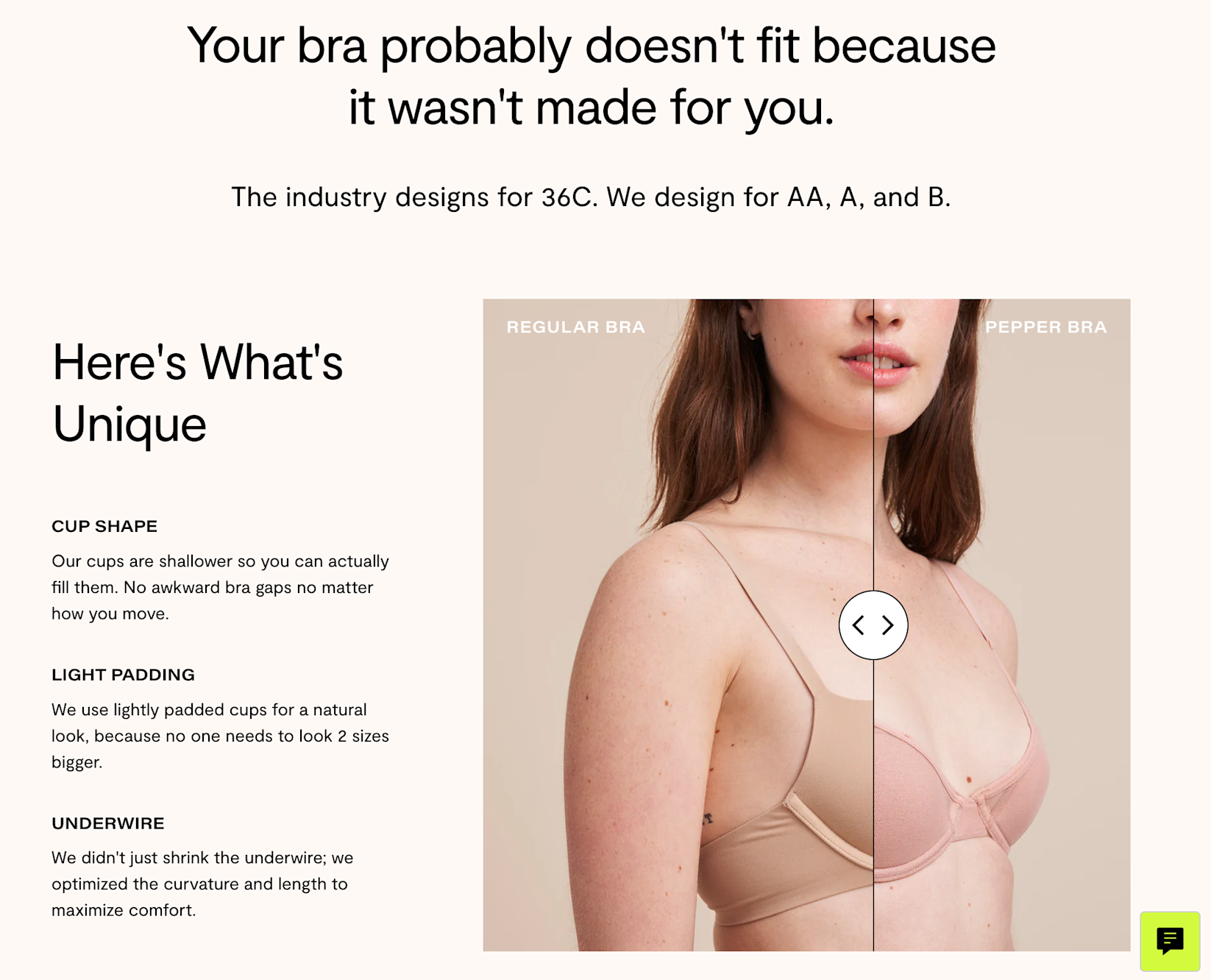
16. Liquid Death
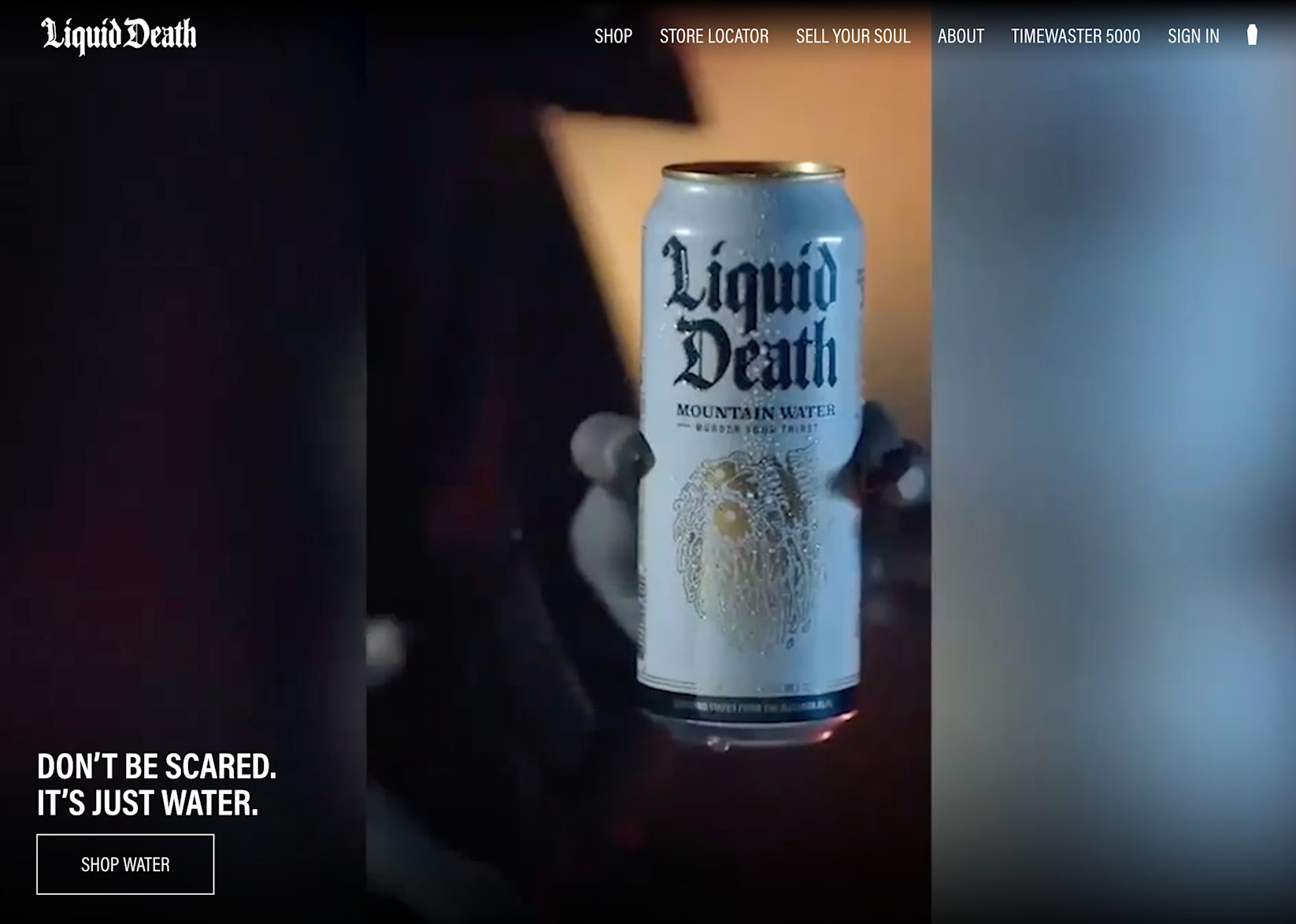
Liquid Deathis a canned water brand. Water is arguably the most generic product a brand could sell, but Liquid Death is as opposite of generic as you can imagine.
With a tagline “Murder your thirst,” Liquid Death regularly doubles down on creative,scroll-stopping campaigns.
For example, the brandhired comedian Bert Kreischerto act as a fitness instructor in a workout video that emphasizes the importance of hydration. The workout in question? It consists of opening a bag of chips, dipping chicken wings in ranch, and eating jalapeño peppers.
Other campaigns includea taste testthat compares Liquid Death to “the most expensive beverages on Earth,” like Spanish squid ink and lobster sauce, as well as the option to “sell your soul” in exchange for joining the brand’s membership.
On a more serious note, Liquid Death is committed to helpingreduce plastic pollutionby donating profits to nonprofits that focus on this issue.
17. Knix
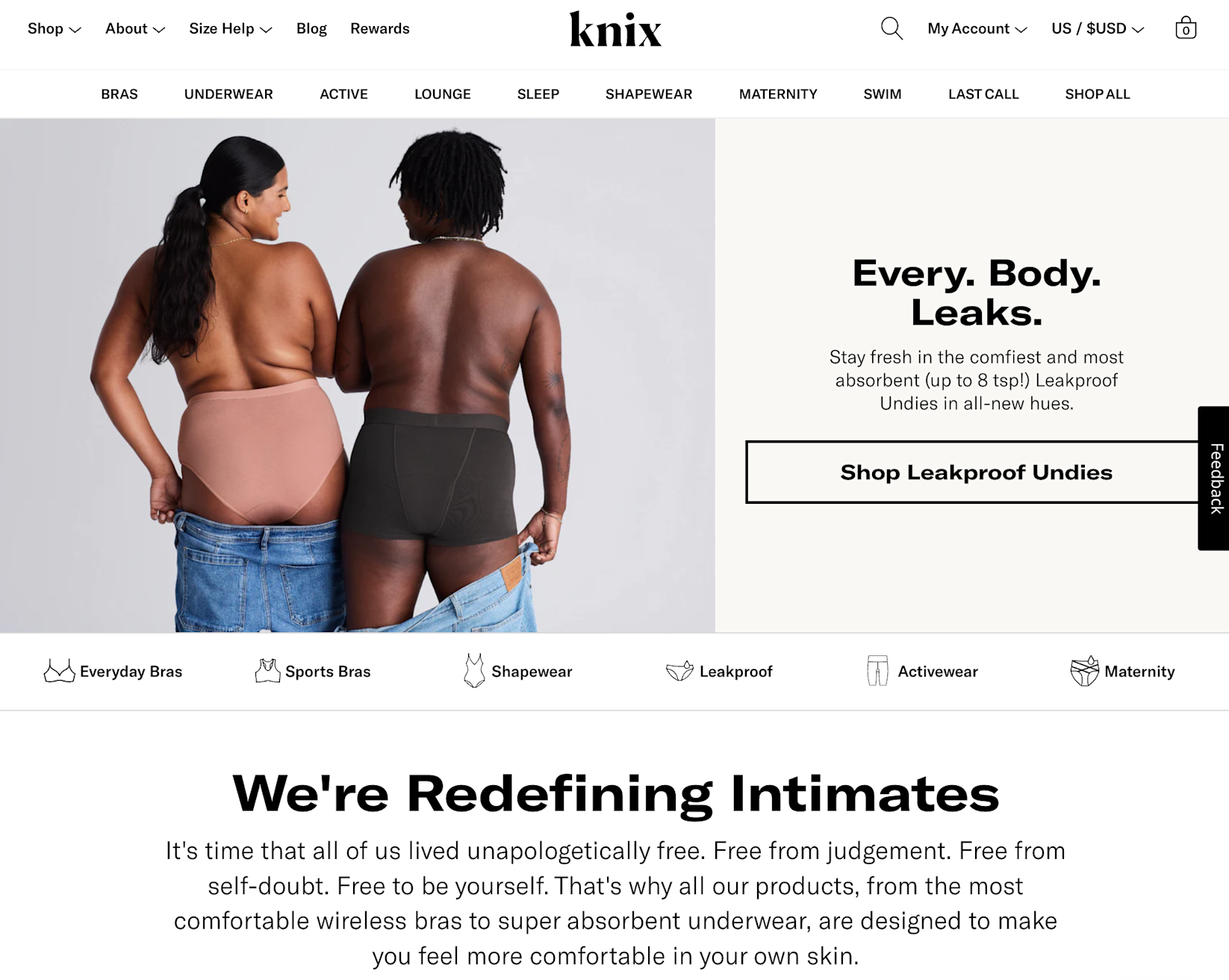
Knixis an underwear brand focused on “making you feel more comfortable in your skin.” Its products include everyday bras, sports bras, shapewear, activewear, maternity underwear, and leakproof underwear.
There are two things Knix does a fantastic job with. First, it represents diverse ages, skin colors, and body shapes throughout all product categories. While it’s certainly not the only underwear company to do so, this is still not a common practice in the ecommerce world.
And secondly, Knix nails its social media strategy, particularly TikTok and Instagram. The brand uses humor and memes to show the benefits of its products, as well as talking head videos to educate and inspire.
A good portion of itsTikTokvideos are from product photoshoots—a fantastic way to let customers see the behind-the-scenes of how product visuals come to life.
18. Diaspora
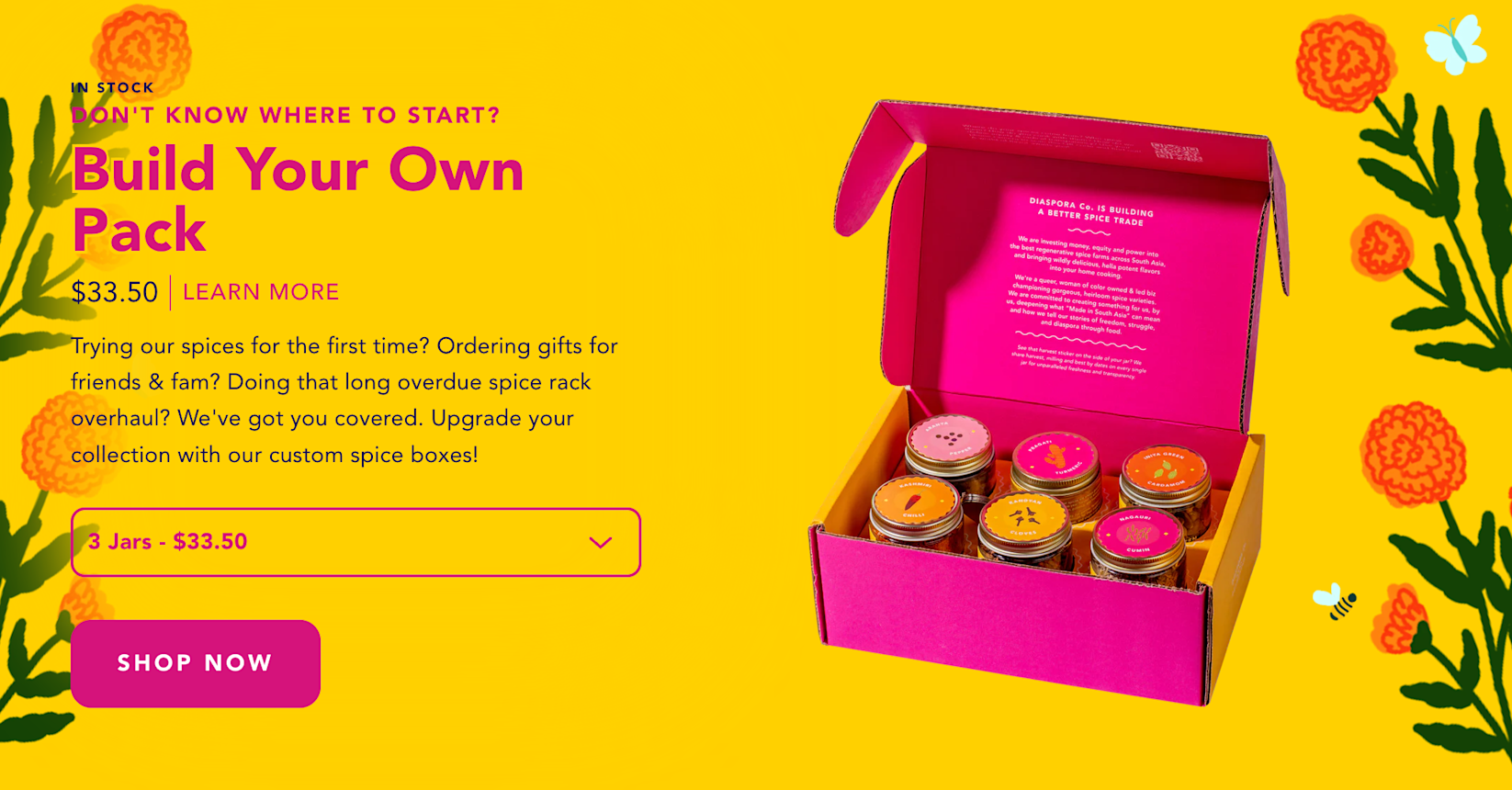
Diasporais a spice brand focused on the history and source of the spices,sourcing them sustainably, and growing the company at the rate of agriculture (meaning when a harvest sells out, that’s it until next season).
Diaspora’s founder and CEO is Sana Javeri Kadri, a member of the Indian diaspora in the US.She describesher learnings about living in a post-colonial world and realizing that direct trade, single-origin spices from sustainable farms are the path to decolonizing the world.
That’s why each product Diaspora sells has a detailed description of its origin and its harvest year. On each product page, you’ll find Diaspora’s equity pledge section, which shows the product’s commodity price, its fair trade price, and what Diaspora pays for it.
Diaspora’s goal is to bring taste into customers’ lives, and do so equitably. The bold visuals—yellow and pink everywhere—is how Diaspora makes sure it doesn’t go unnoticed.
19.Braxley Bands
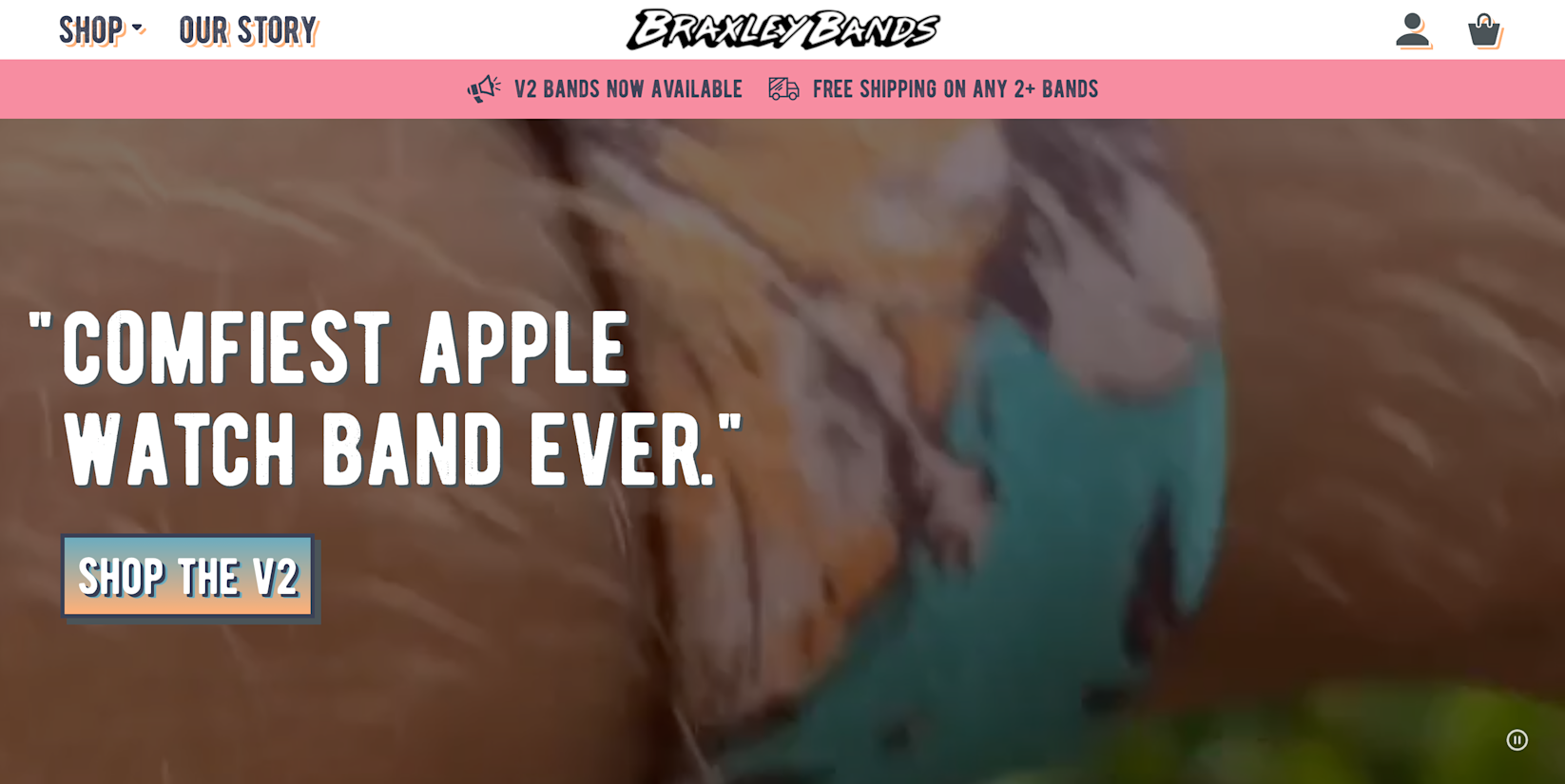
Braxley Bandsis a brand of the “comfiest Apple Watch band ever”—washable, stretchy, and available in dozens of colors and patterns. The brand started as a marketing class project in 2017 and reached$100,000 in monthly revenueby 2019.
The brand does a fantastic job building buzz around the product. For example, customers can get VIP access to a product launch through a specificSMS signup, or order a mystery box with three surprise bands.
And a fantastic campaign that rewards customer loyalty, creativity, and engagement is Braxley Bands’ Halloween contest. Customersdress up as a Braxley bandand get a gift card for a free band. The winner gets a new Apple Watch—a genius way to create product hype.
Finally, Braxley Bands’ TikTok is one to take inspiration from. You’ll find everything from basic demos to memes and styling tips—and basic videos likethis onewith over a million views prove that you don’t need to reinvent the wheel for your videos to get traction.
20. Cometeer
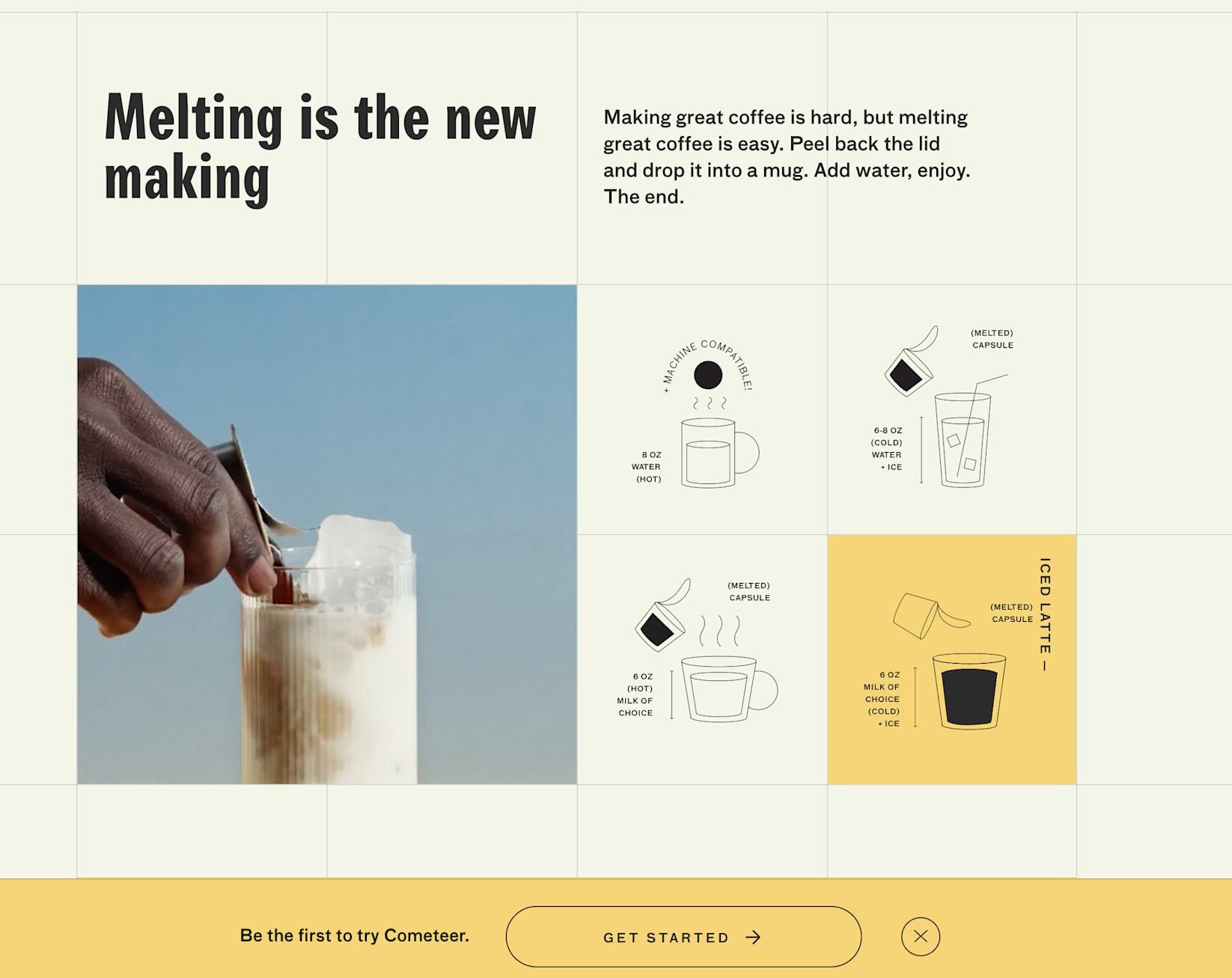
Cometeeris a brand of frozen coffee capsules. Once these capsules reach customers’ freezers, they can stay there until customers are ready for a hot coffee, ice coffee, cocktail, and beyond.
Cometeer is about making high-quality coffee practical in any situation, like work and travel, and seems to be the first brand to take the frozen capsule approach.
It’s easy to confuse these capsules for regular coffee machine capsules because they’re somehow similar and also nothing like them. TheHow to Meltguide for different types of drinks makes it easy to quickly grasp the process.
The company relies on word of mouth to reach new buyers. Customers can join a “give $25, get $25”referral program, as well as use the option to easily buyCometeer as a giftto someone else.
21. Biossance
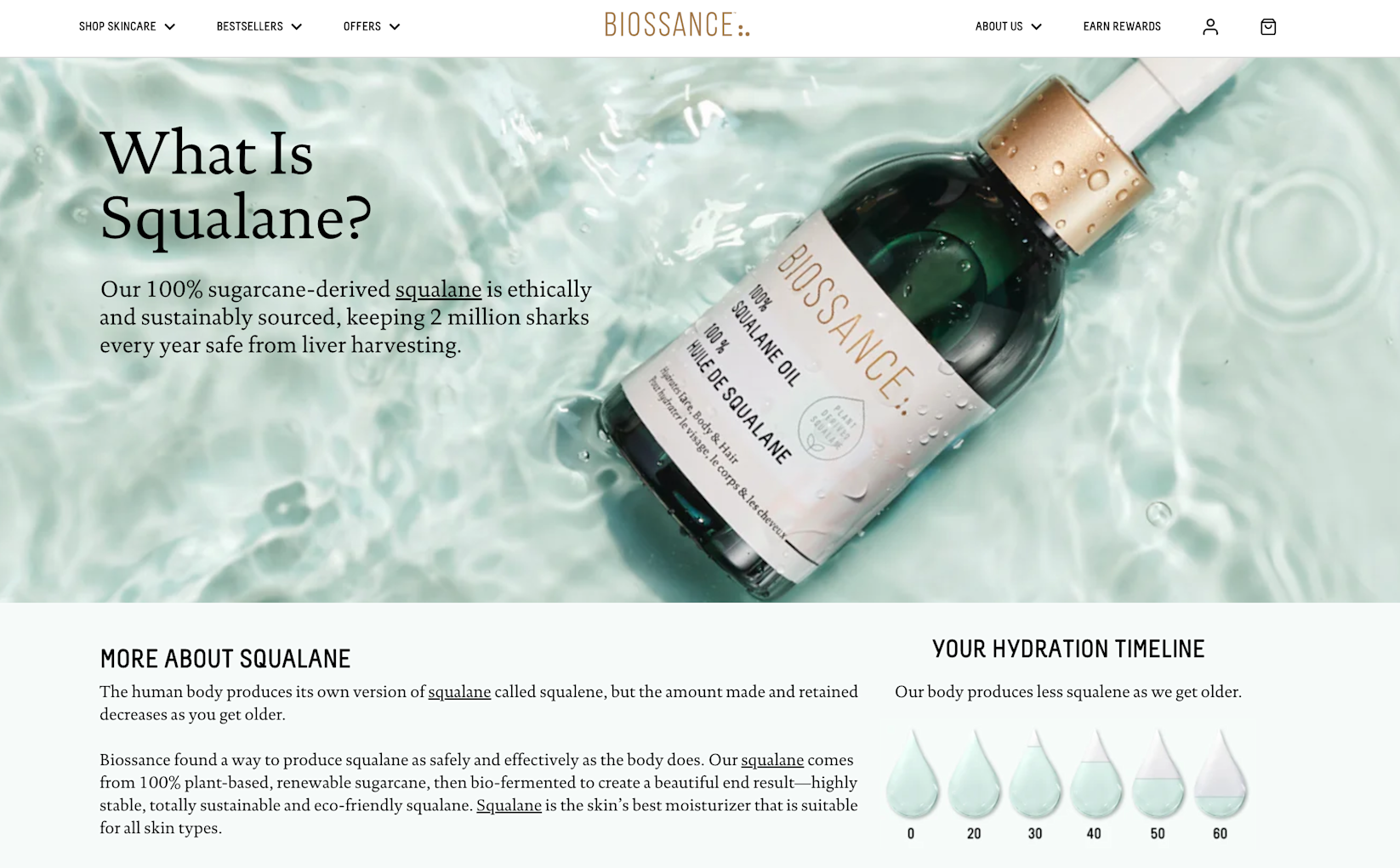
Biossanceis a clean, vegan skin care brand with a tremendous focus on educating consumers about ingredients, how they impact the skin, and how they’re sourced.
Lab Notes, Biossance’s blog, hosts more than 100 articles on topics like squalane, sunscreen, exfoliation, vitamin C, skin care in different seasons, and more.
The brand’s resource called theingredients librarylists dozens of common skin care ingredients and their Environmental Working Group (EWG) ratings, which shows suspected levels of hazards known for each ingredient.
In fact, education is such a big part of Biossance that the brand employs roles like Director of Global Education—a crucial one for creating an epic library of insightfulvideos, courses, webinars, and articles customers can rely on to make the best decision for their skin.
22. Ten Little
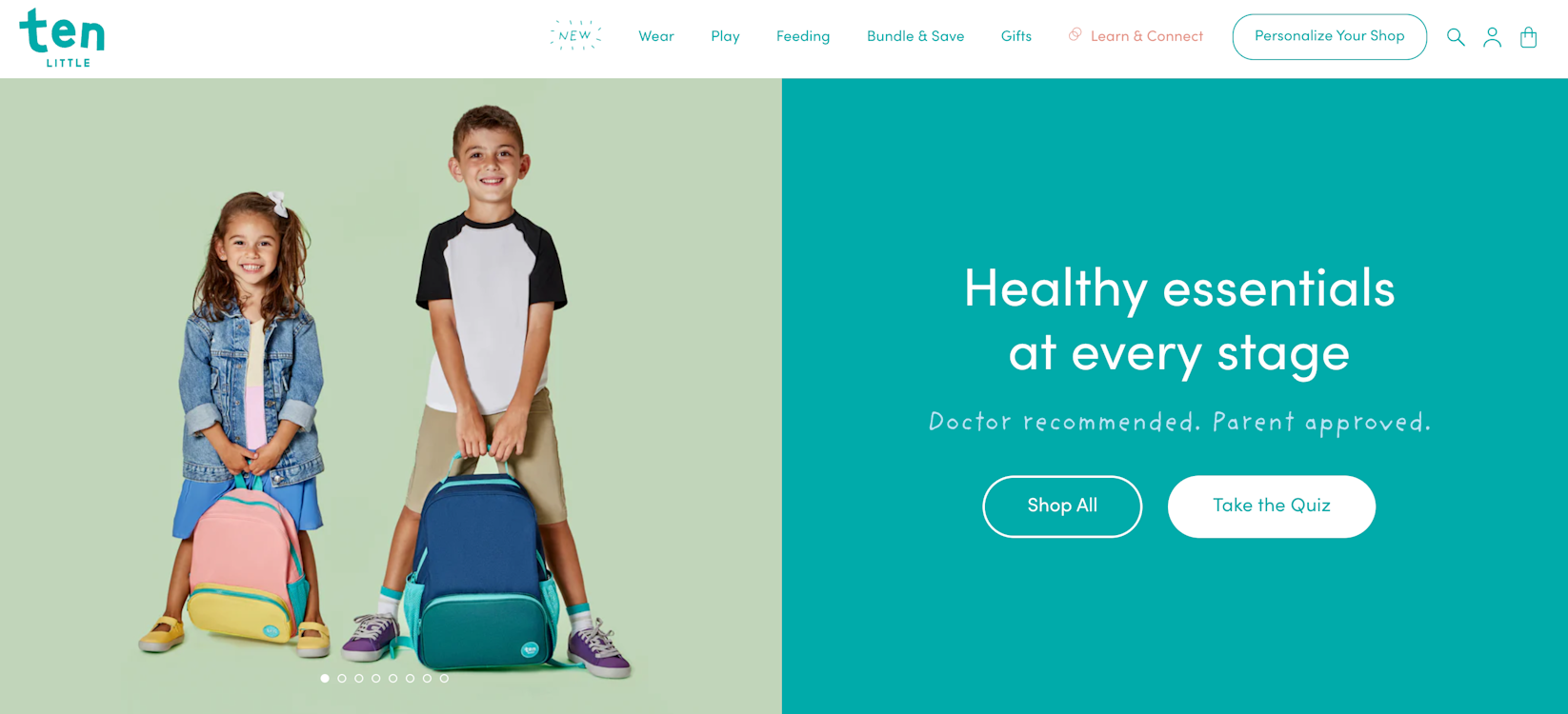
Ten Littleis a brand of clothing, play, and feeding products and resources for children.
它的目标是为孩子购物很容易。“current kids’ shopping options lack expert curation and testing and do not provide personalized guidance around a child’s own developmental patterns, when in reality, each child is unique and ever-evolving,” Fatma and Julie, Ten Little founders, state on the company’sAbout page.
Parents cantake a quizto determine the correct footwear size and development stage of their child to help them shop easier. On top of that, Ten Little’sLearn & Connectplatform helps parents find expert-vetted answers on topics like potty training, movement, and sleep.
Unsurprisingly, that customization is what parents love the most.Maria West, a DTC writer and a mom of two, said that Ten Little is her family’s go-to choice for toddler shoes. “I had an early walker—nine months—and knew the adult lookalikes weren’t the best for learning feet. I love the structure of shoes and the limited, basic styles. Only ones we buy,” she says.
23. August
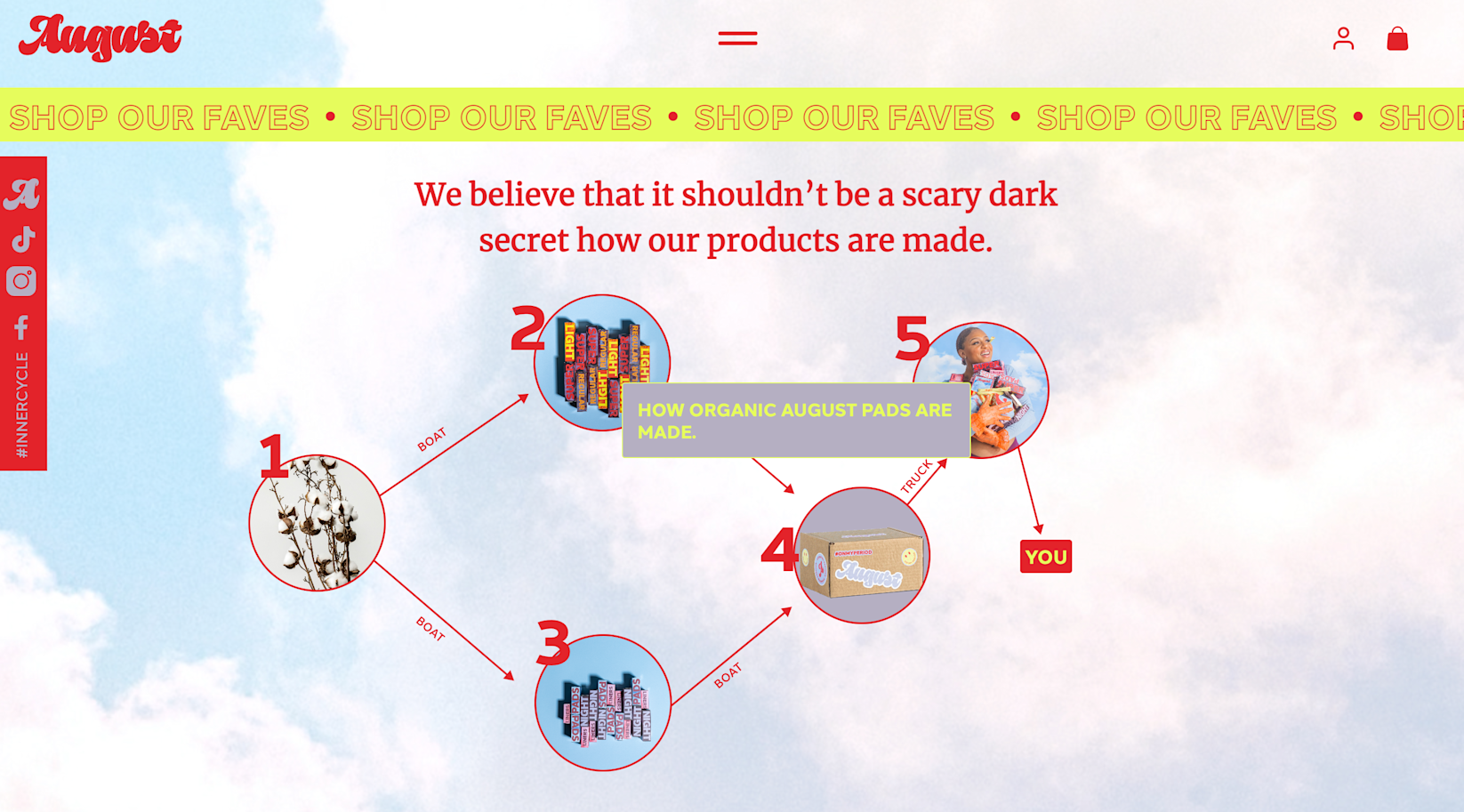
Augustis a biodegradable period care brand selling pads, tampons, and liners. Beyond buying individual products, customers can subscribe for monthly or quarterly deliveries of either a specific product or a custom-built bundle.
August’s mission is three-fold: giving back, sustainability, and culture.
By giving back, it tackles period poverty issues. Sustainability includes being carbon-neutral, sharing how products are made, hiring ethical labor, and using natural materials.
And through culture, August focuses on talking about periods to remove the stigma around them, including all menstruating people into period conversations and products, and talking to customers to create the best products possible for them.
24. Appointed
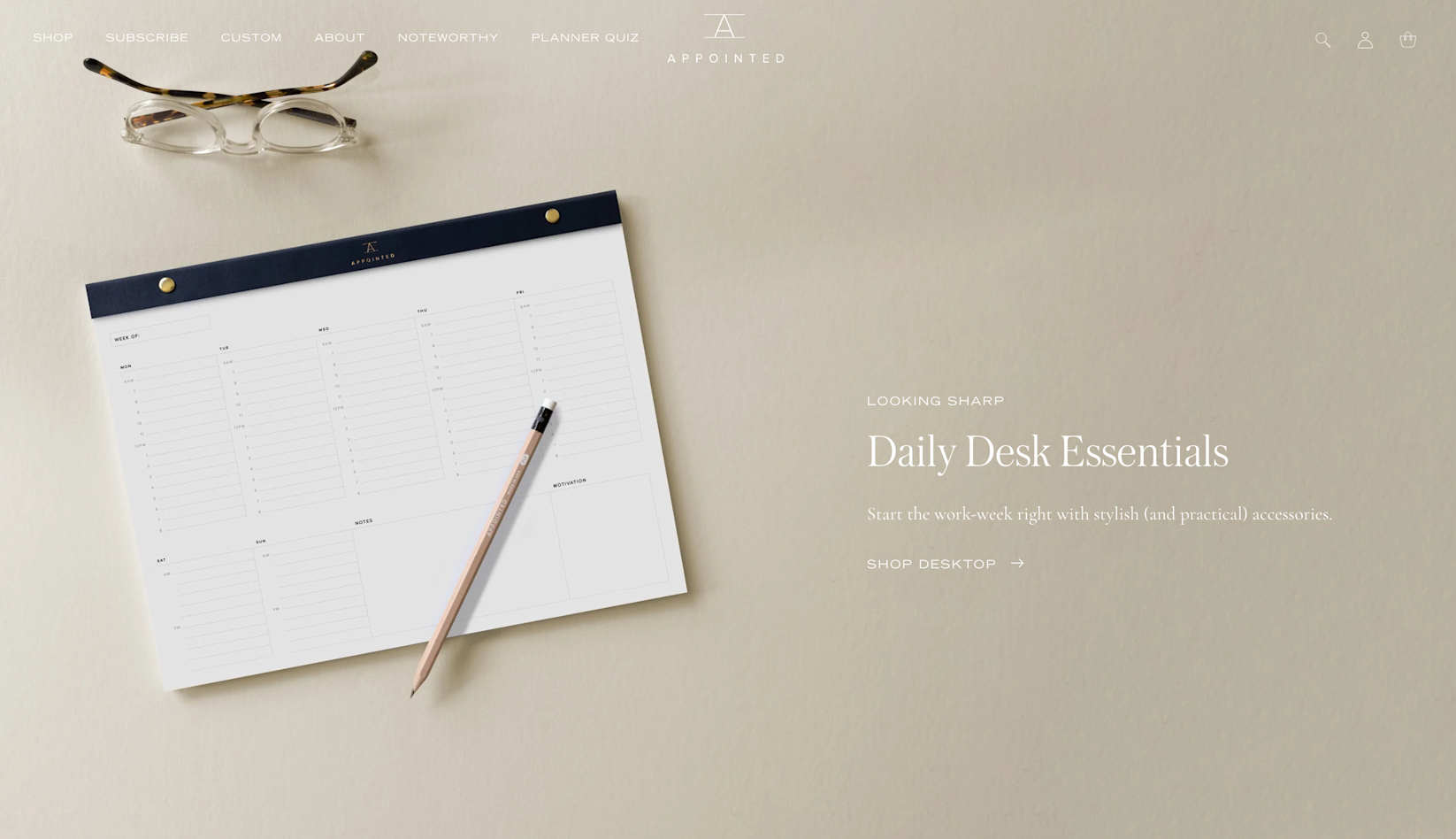
Appointedis a brand of planners, notebooks, calendars, and stationery. It serves customers through its online shop, as well as a flagship store in Washington, DC, adjacent to its production studio.
The brand is focused on the details: showing intricate features of pages inside the planner, giving customers the option to add a monogram to the covers, and displaying beautiful lifestyle imagery of its products.
Appointed’s clean, minimalistic aesthetic is everywhere: not just in the online store and everyemail, but also in its physical shop. The brick-and-mortar store is about “not only showcasing our full suite of products but providing an immersive experience built on creativity and discovery,” the teamexplains.
25. Glamnetic
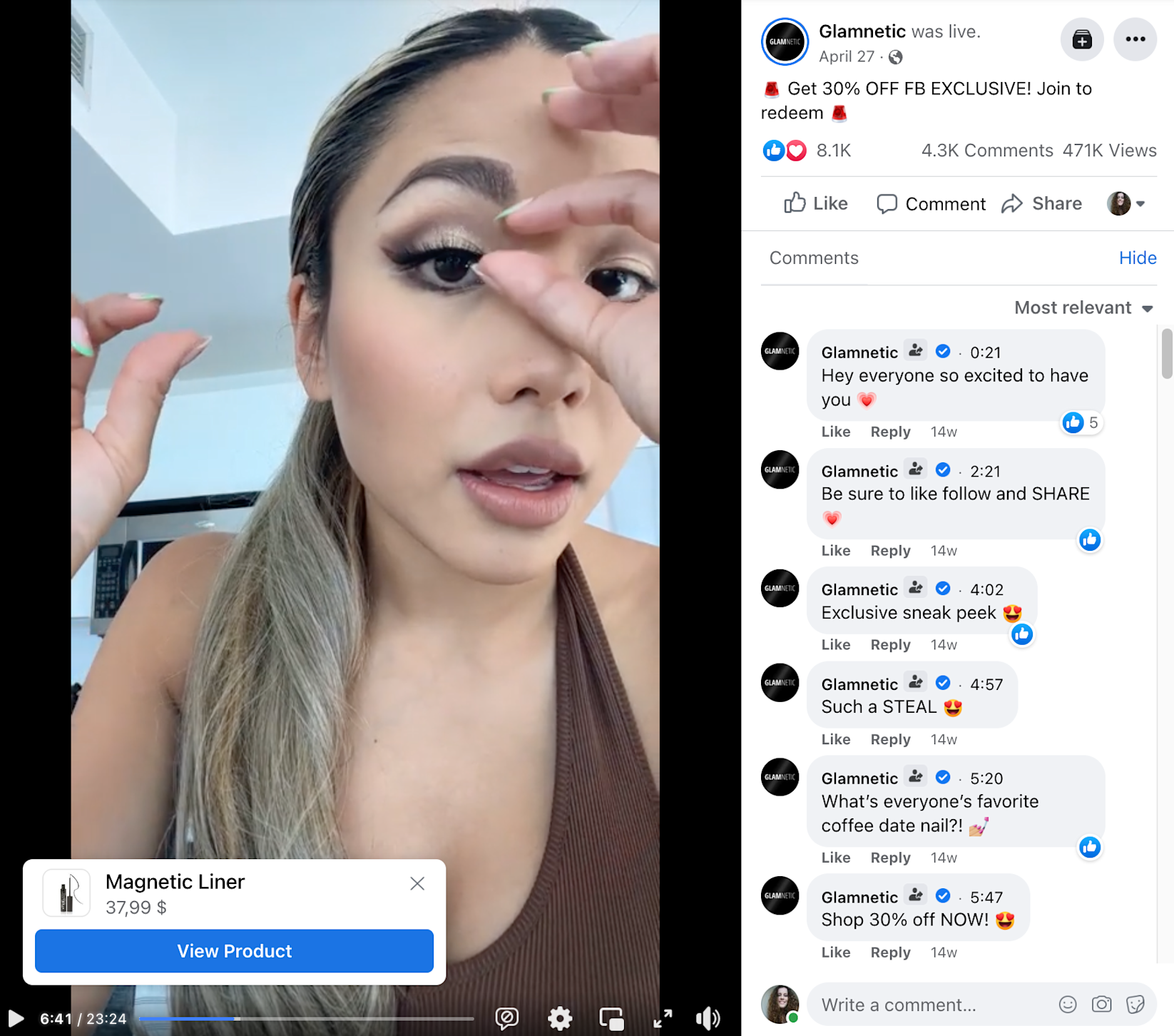
Glamneticis a beauty brand known for press-on nails and magnetic lashes. Its strongest suit issocial commerce, the strategy of selling products through social media.
Platforms like Facebook, Instagram, Pinterest, and TikTok now let customers make purchases directly within the platform. Glamnetic makes the most of this withlive shopping.Ann McFerran, Glamnetic’s founder, goes live on Facebook, demonstrates different products, and offers limited-time discounts for those watching live.
Glamnetic grew from $1 million to$50 million in revenuewithin a year and is backed by a large, engaged community of customers and fans. That’s the power of social media, social commerce, live videos, and genuine relationships with influencers.
26. Caraway
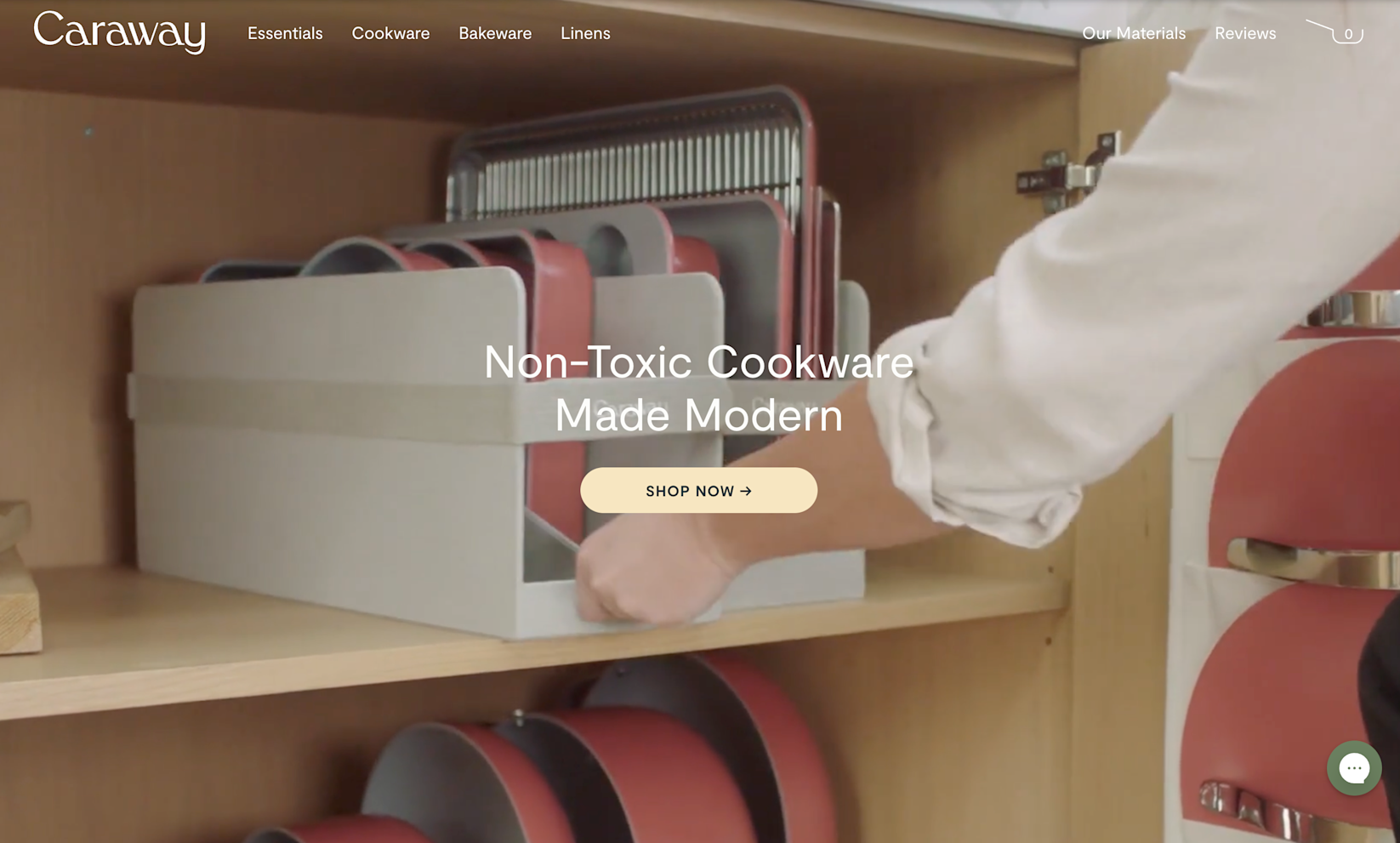
Carawayis a modern take on non-toxic, non-stick cookware. Its products include pots, pans, bakeware, and linens.
The brand is on a mission to provide safe cookware options for consumers—those that aren’t made of Teflon and other potentially toxic materials. Jordan Nathan, Caraway’s founder,launched Carawayafter his own experience with Teflon poisoning.
One look at Caraway tells you that this mission is not just about safety and ease, but also aesthetics. Caraway products are beautiful, with details and colors made to fit into any home.
Caraway’s bestselling options are pre-curated sets for cooking and baking with two benefits: they’re a better deal compared to buying individual products included in these bundles, and they come with storage organizers.
27. JuneShine
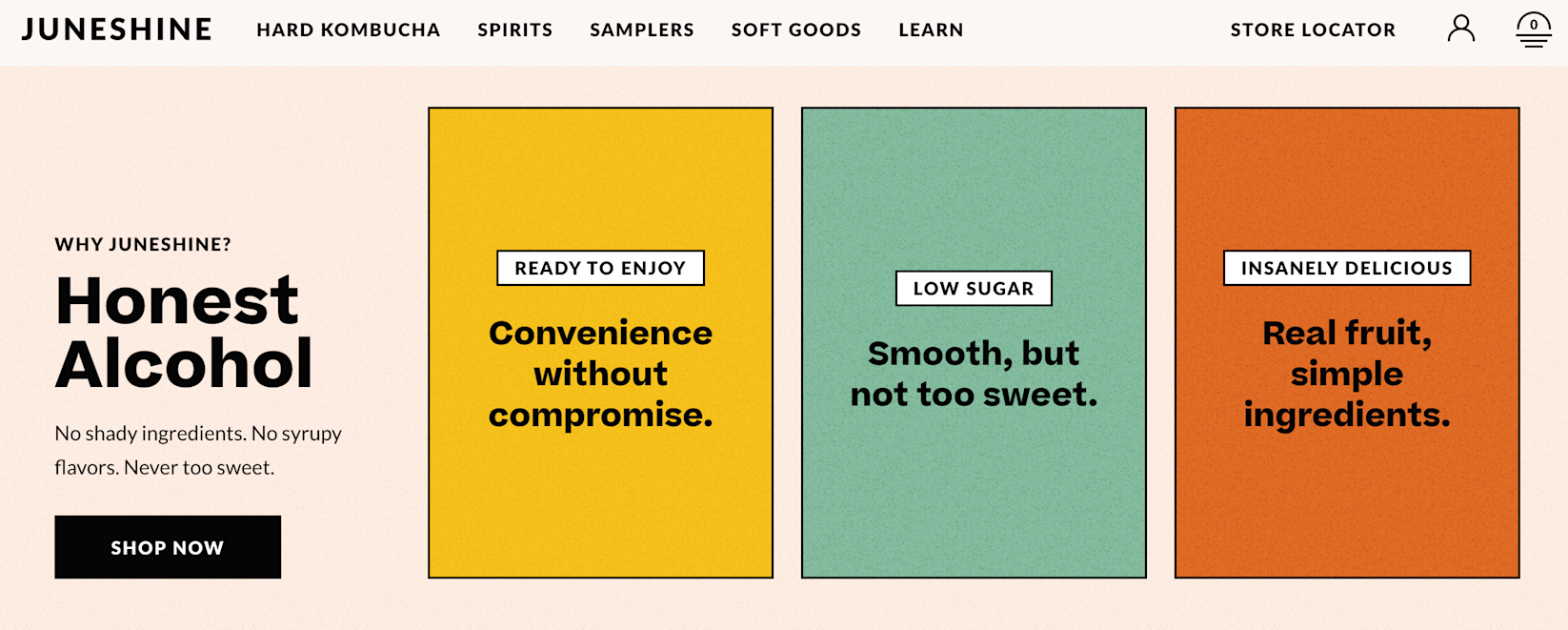
JuneShineis a brand of hard kombucha and canned cocktails. “Why do we know so much about the food we eat, but not the alcohol we drink?” That’s the question that led JuneShine’s founders to try brewing their own hard kombucha.
While JuneShine ships products to its customers’ doors and has earned a place on shelves countrywide, it also fosters in-person connections in their California-based tasting rooms. There are launch parties for new product releases, and JuneShine ranch hosts weekly trivia nights.

Another one of JuneShine’s strategies is partnering with athletes, artists, and creatives—some of itsambassadorsinclude comedian Whitney Cummings, wakesurfer Evan Mock, and songwriter and producer Diplo.
JuneShine tripled its revenue from 2019 to 2020 and doubled it the year after, which helped it win a$24 million investmentand fuel further growth.
28. Hint
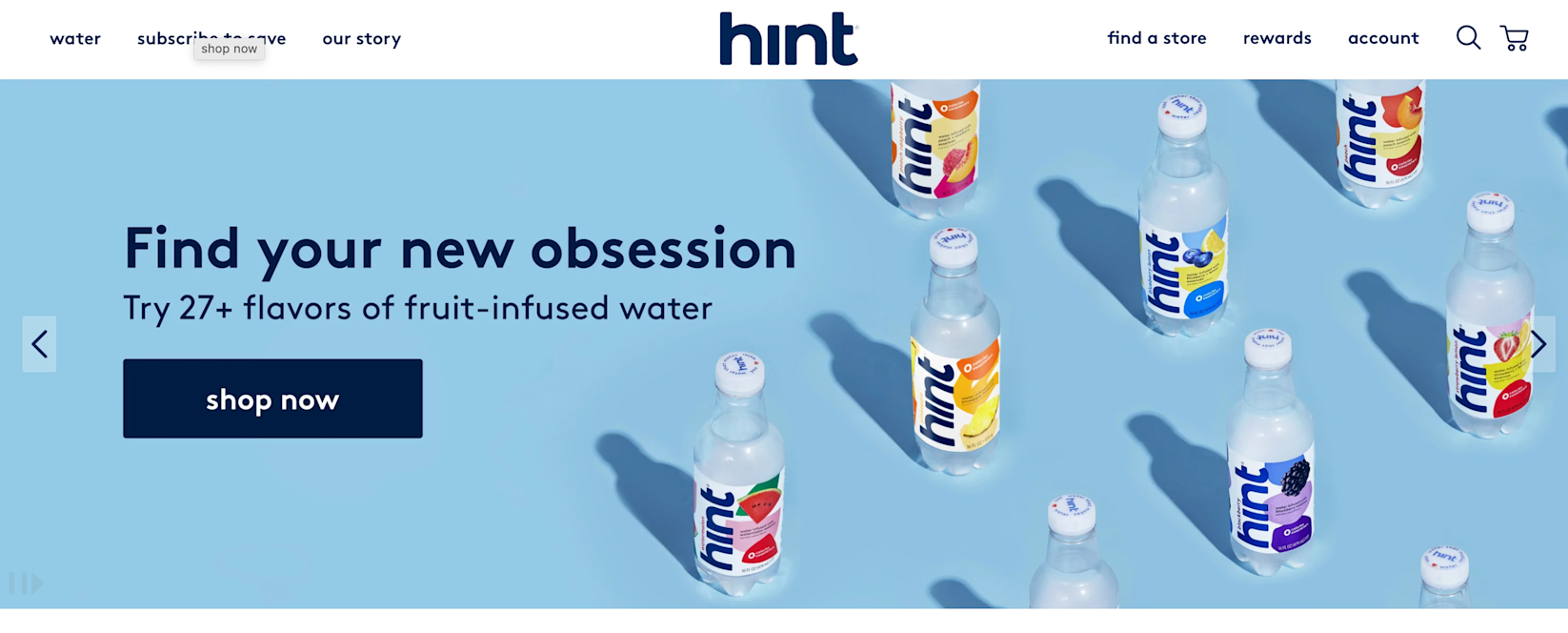
Hint is nailing the strategy of bundling its products to drive sales. For example, Hint’s bundle for new customers contains 36 bottles for a 45% lower price than usual and suggests pre-selected flavors to remove decision fatigue.

Another example are new launch bundles. Nik Sharma, CEO of Sharma Brands, worked with Hint and noted the brand was ahead of the curve when it came to bundling new products.
The reason why is four-fold. These bundles include new flavors, keep the average order value high, remind the customer of the product variety, and hit the free shipping threshold. A win for Hint and a win for the customer.
29. Lovevery
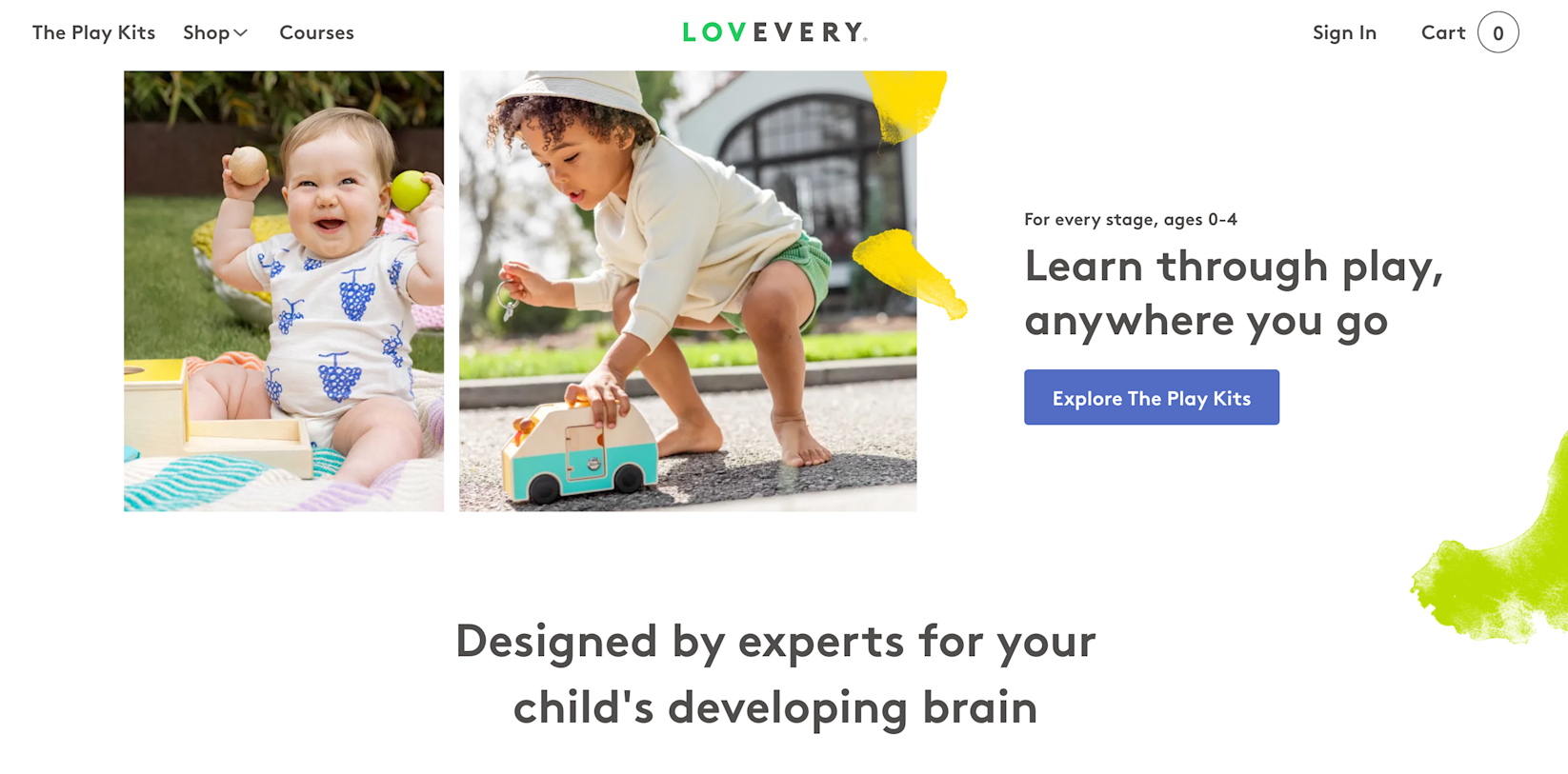
Parents want the best for their kids, and knowing what “best” means can be challenging at the best of times.
Lovevery, a brand of toys and subscription boxes, takes this burden off parents’ shoulders. “We did all the research so you don’t have to,” its homepage promises.
Lovevery的游戏包作为一个订阅、档次e that delivers a set of toys every two or three months based on the age and developmental stage of the child, up to four years of age. This is a long time to serve a customer (in this case, both the parents and the child) and prove the subscription is worth it—a big task. Lovevery seems to hit the mark.
The brand also offers paid courses on topics like tummy time and weaning, as well as a free newsletter with activity ideas and child development insights based on the child’s age.
How Shopify can help your DTC brand grow
Selling directly to consumers gives you unlimited potential to reach new customers, full control of the purchase journey, and a chance to personalize every interaction.
Shopify便于运行您的DTC的品牌single platform. Out of the 15 fastest growing DTC brands ranked in2PM’s DTC Power List, 13 are powered by Shopify:

Just like these brand examples, you can sell recurring subscriptions, ensure a seamless shopping experience on every channel (including social commerce and retail), create a loyalty program, and offer flexible delivery and payment options.
Want to see how companies like Lindt, Heinz, and Rebecca Minkoff are making this happen with Shopify, and how you can, too? Grab our direct-to-consumer guide to get started.
Direct to Consumer (DTC) FAQs
What does direct-to-consumer mean?
Direct-to-consumer (DTC) is when a brand sells directly to the consumer. Previous to DTC, brands would sell their products in larger retailers. If you are a shoe brand, chances are you would sell your brand in a shoe store.
What is a DTC brand?
A DTC brand is one that manages the entire supply chain process from manufacturing, to marketing and selling to the consumers. The DTC brand is able to control the whole buying experience. An example of a DTC brand is Allbirds.
Is DTC growing?
DTC, direct-to-consumer, has quickly expanded in most recent years due to the 2020 pandemic. According to eMarketer, direct-to-consumer sales has grown by 15.9% YoY.






